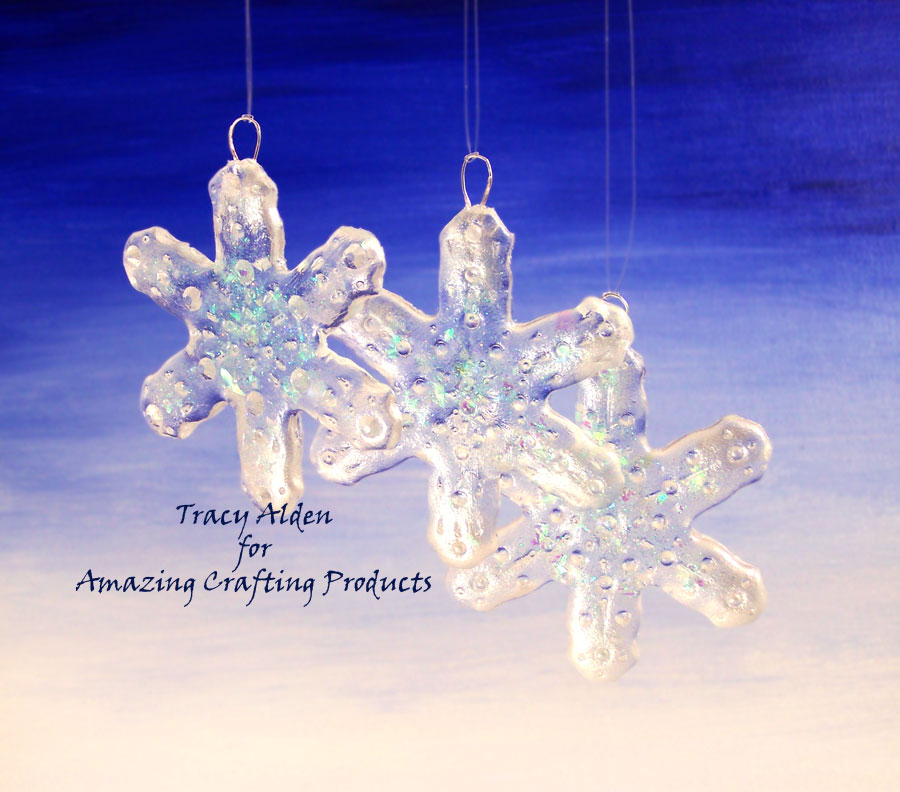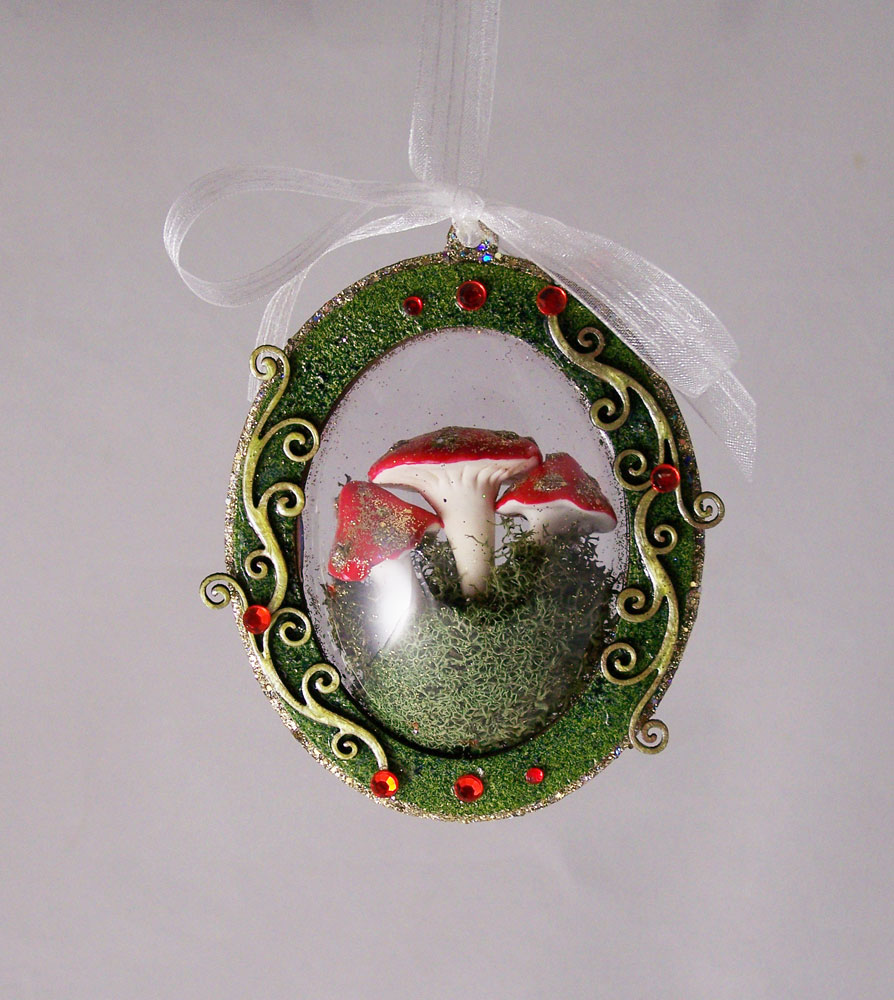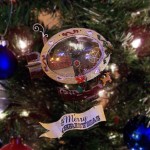The Mermaid’s Necklace, a #Cre8time fish-tale
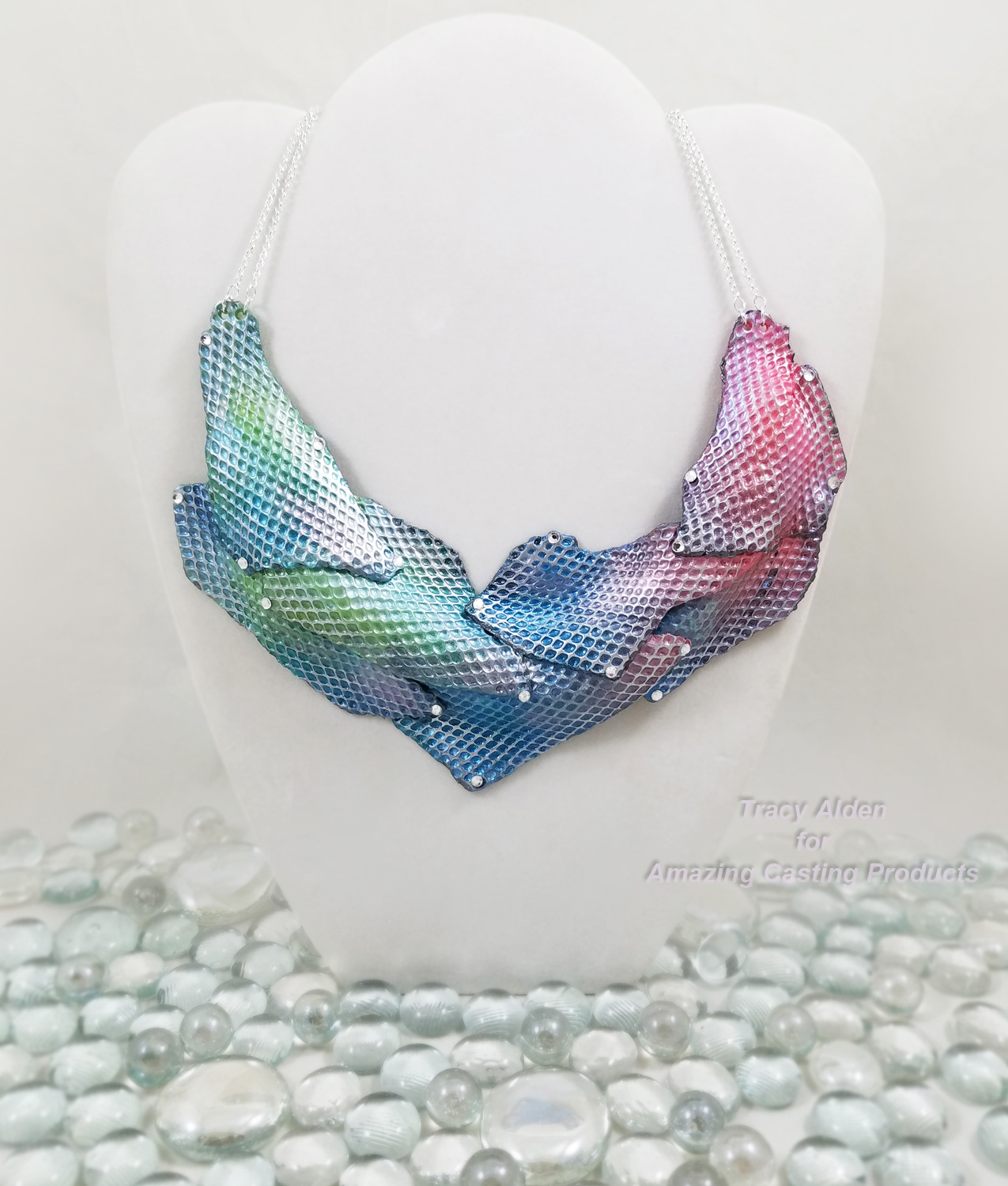
A great inspiration for my art is looking for and finding textures to duplicate and/or mold. While my project might look like something from the sea it started in a by far more mundane environment, my office. My metal pen, paper and paperclip holder is made out of mesh, a delicate diamond pattern, reminiscent of tiny fish scales. With the help of Amazing Mold Putty I could transfer this lovely pattern to Premo Accents polymer clay to create a necklace fit for a mermaid!
Supplies:
Amazing Mold Putty
Alumidust
Alumilite Metallic Powder
Premo Sculpey Accents Multipack 12 pc Mixed Effects(using Bright Green Pearl, Sunset Pearl, Peacock Pearl from this pack)
Premo Sculpey Accents Translucent
Sculpey Glaze Gloss
Acrylic Roller
Stylus (small sizes)
Pasta Machine (optional but helpful)
Ceramic Tiles
Craft Knife
Small Paint or Makeup Brush
Beacon Gem-Tac Glue
Rhinestones
Silver tone jewelry chain and jumprings
Metal mesh office pen and note holder or a piece of heavy weight mesh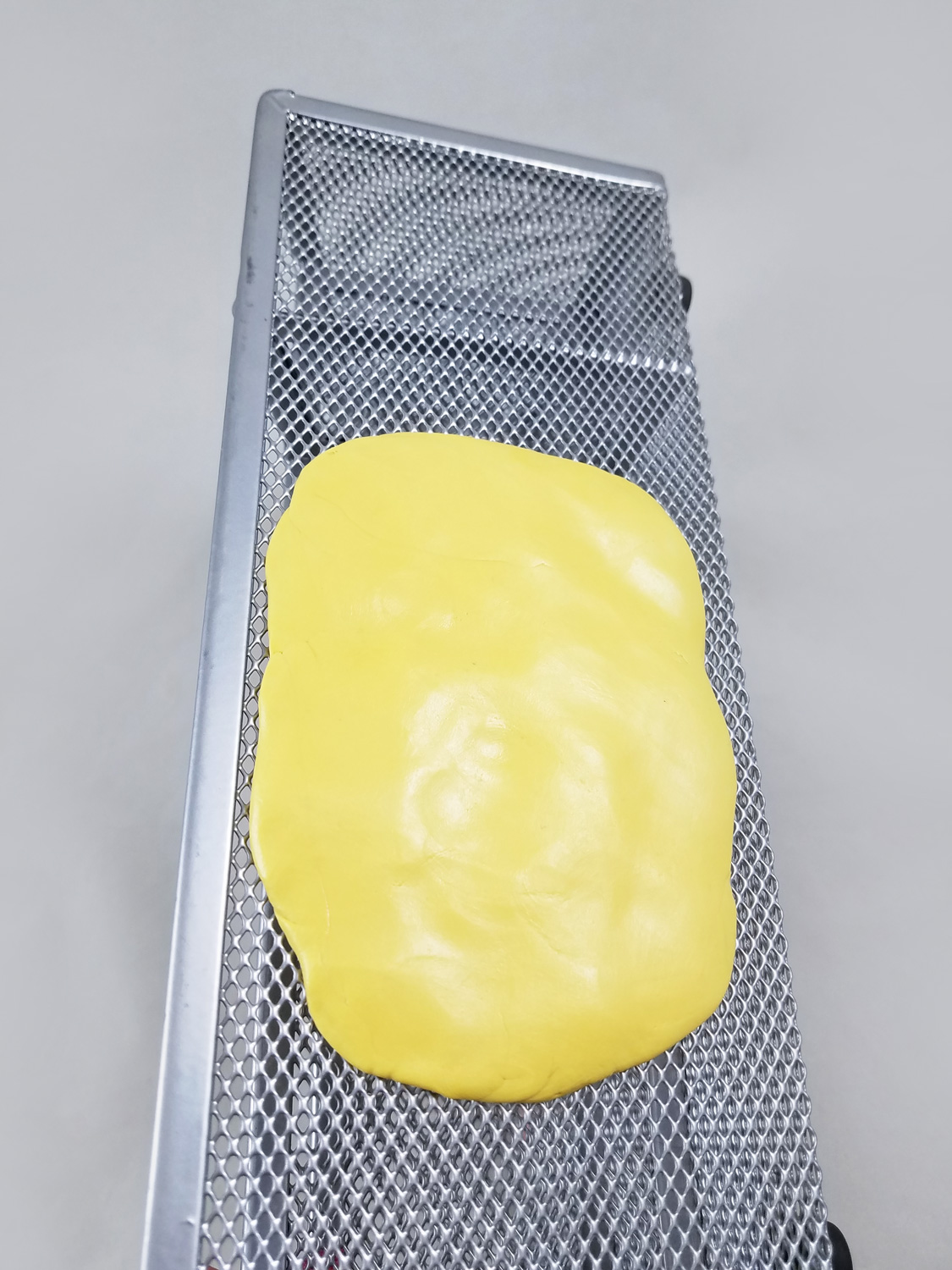
I mixed up some Amazing Mold Putty {CLICK HERE to view mixing/preparation}, and applied it to the largest open part of the mesh office supply holder. I was careful to press the Mold Putty through the mesh to get detail, but not too far that the mold putty would seep through creating weak points and holes in the mold.
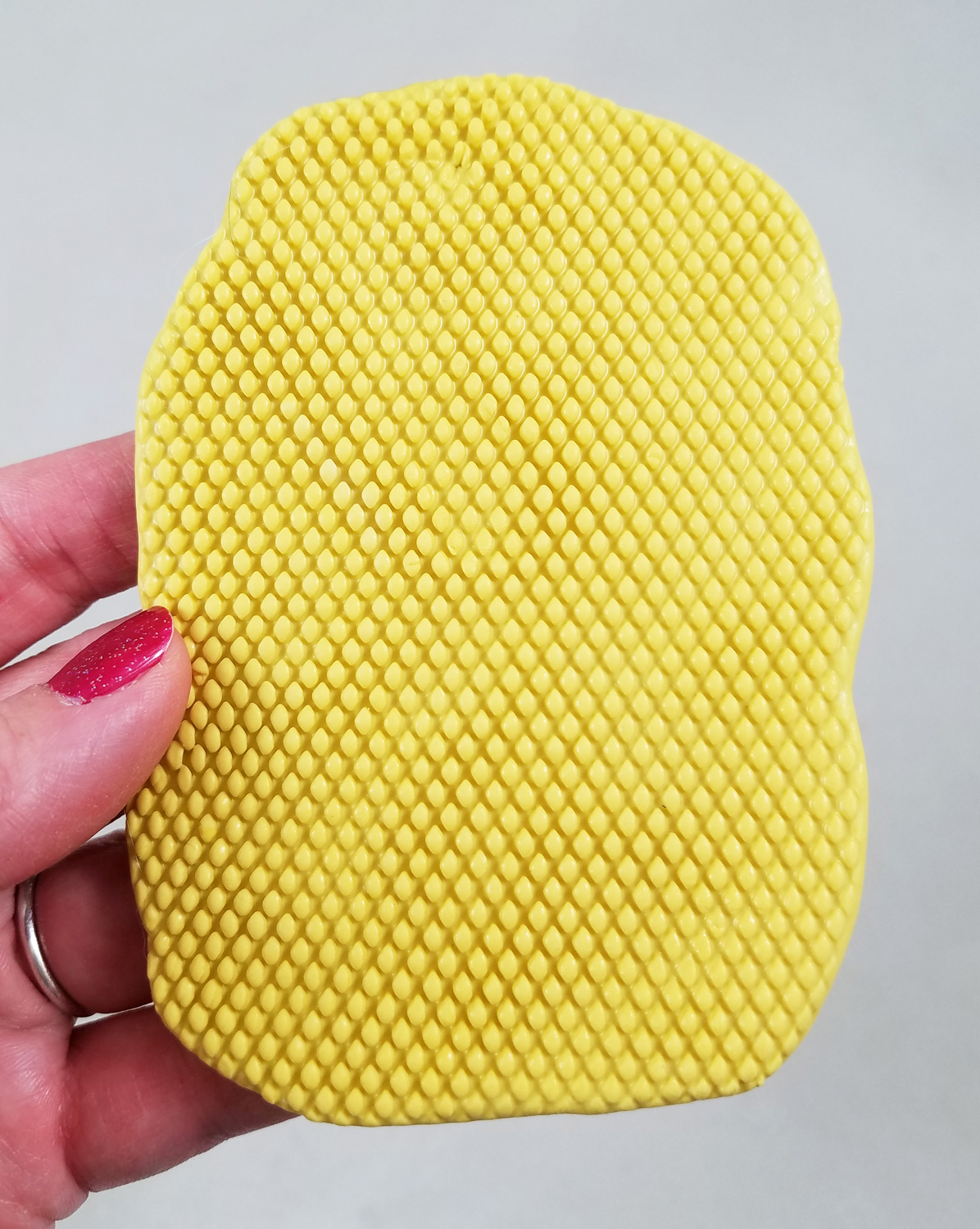
Once the Mold Putty was cure I carefully peeled it off the wire mesh. Now I had a perfect texture plate that had a close resemblance to tiny fish scales.
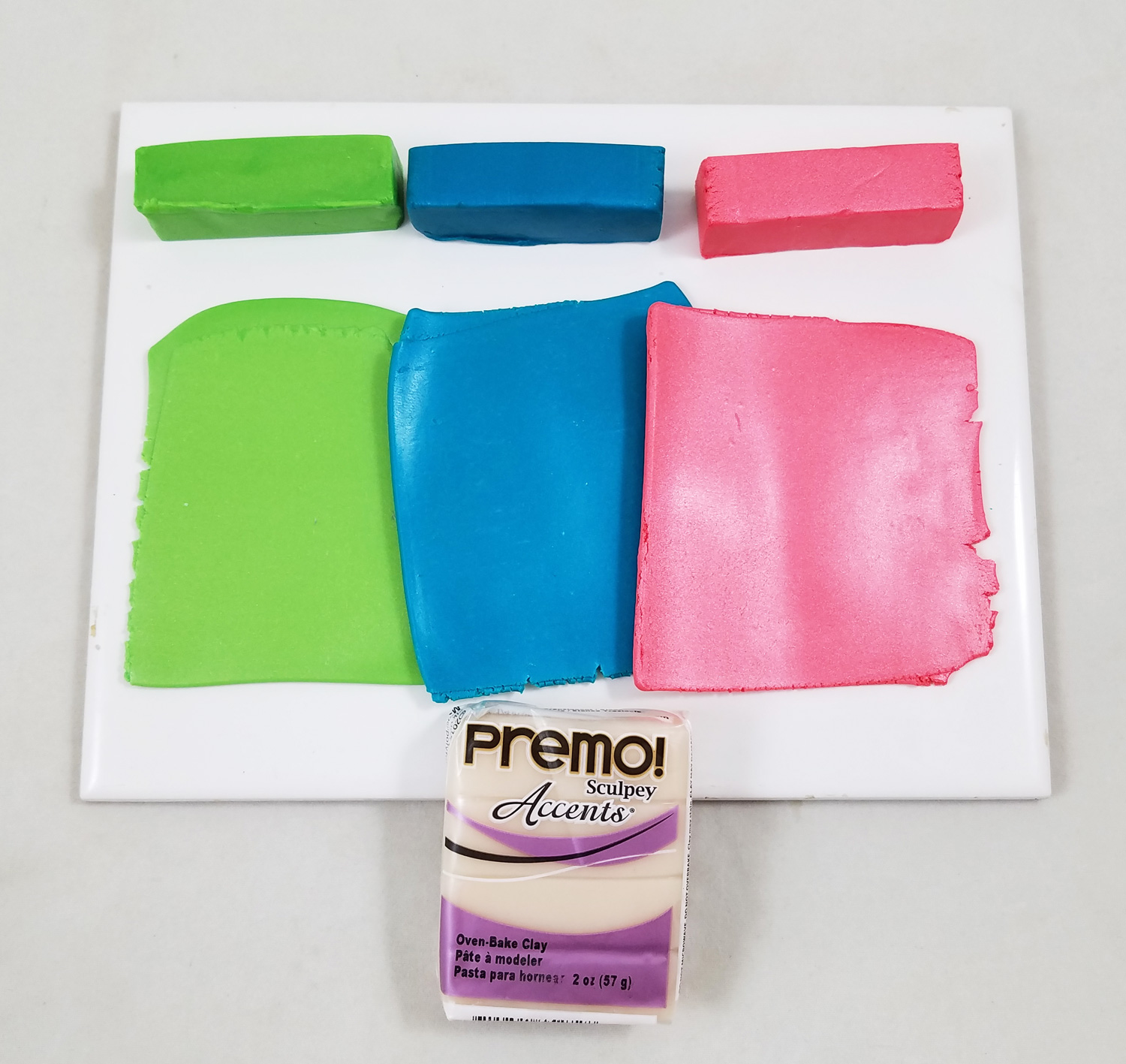
Using a pasta machine (devoted to craft use only) set on the thickest setting, I conditioned some Premo Accents Translucent polymer clay. I added the translucent clay to one half of the Bright Green Pearl, Sunset Pearl, Peacock Pearl clay bricks found in the Premo Accents Multipack.
*The addition of the translucent clay to the colored clay creates a look of slightly translucent fish scales once the clay is baked.
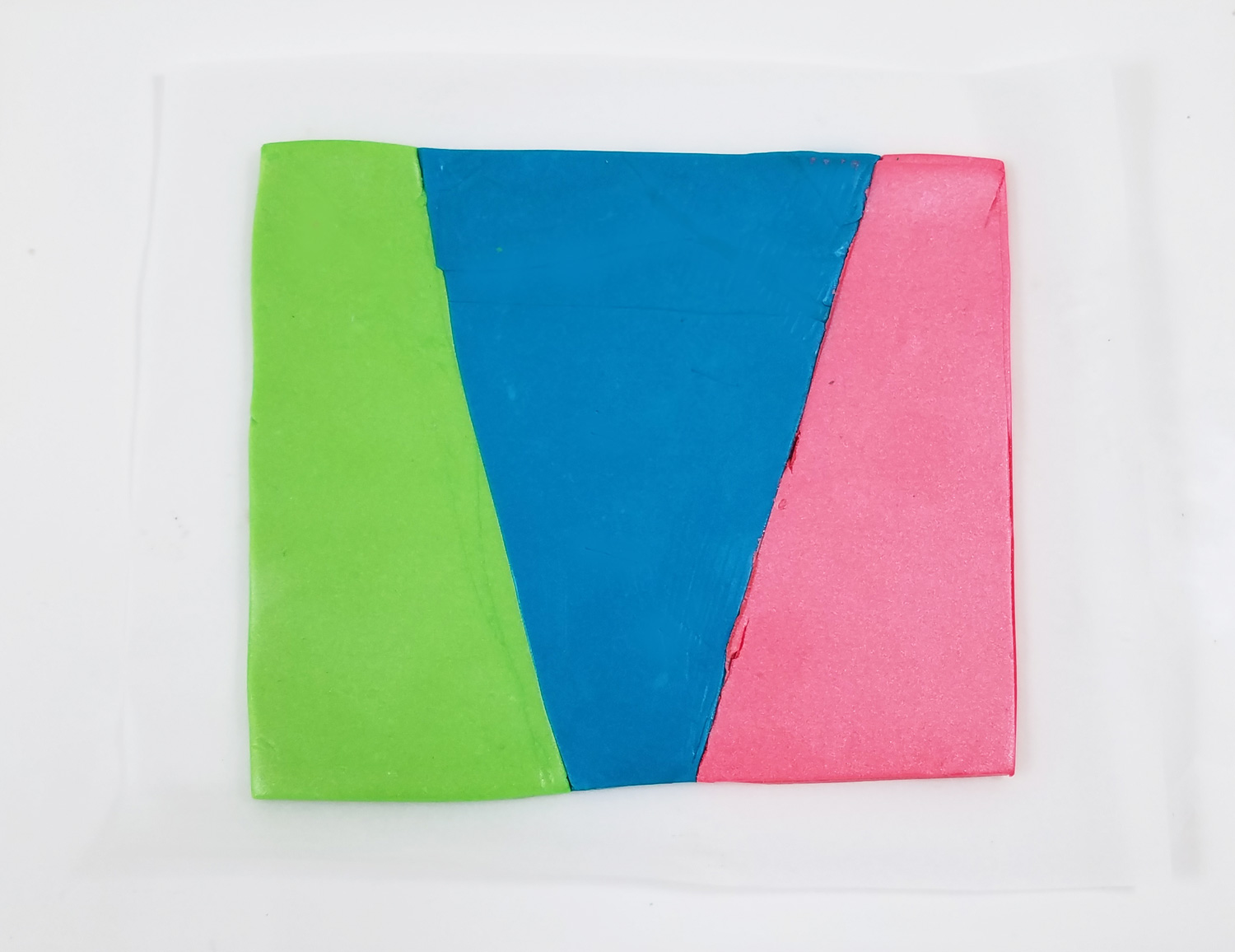
Next I cut my conditioned clay into wedges and pushed the edges together as seen in the above photo. What I created is the start of what is call an Offset Skinner Blend technique. This technique was developed by a talented polymer clay artist named Judith Skinner in the 1990s, which creates a stunning and smooth blend of colors in polymer clay when clay is cut into triangles and then run through a pasta machine multiple times. In the photo you can see those are not triangles, those are purposefully offset and trimmed so that it will create areas of pure unblended color with the blended portions, giving a more vibrant contrast in the final blend.
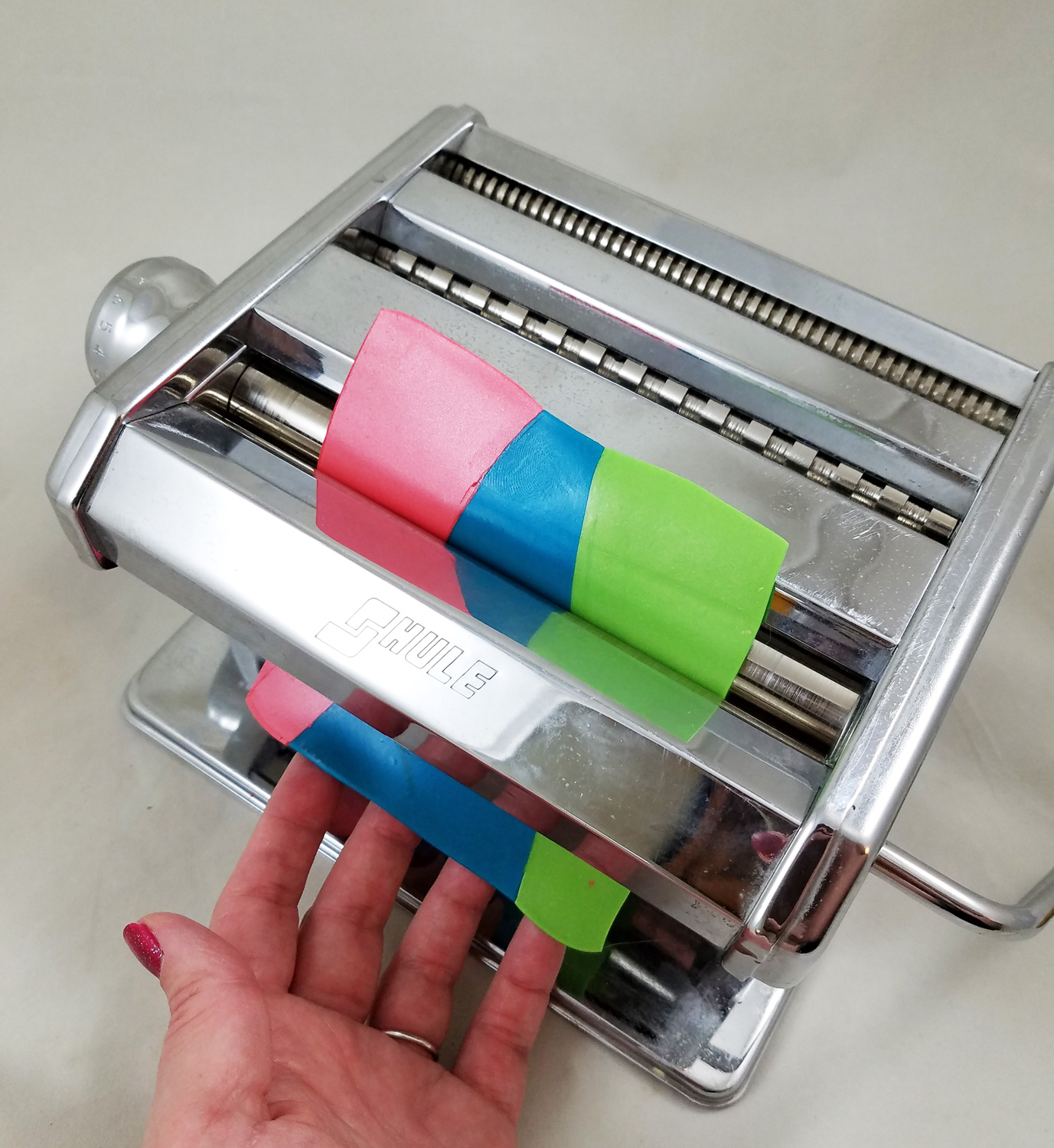
Using the thickest setting of the pasta machine I inserted the clay sheet, with the edge of of all three colors first; this made sure all the seams are pressed lightly together. I caught the clay sheet as it came out of the pasta machine.
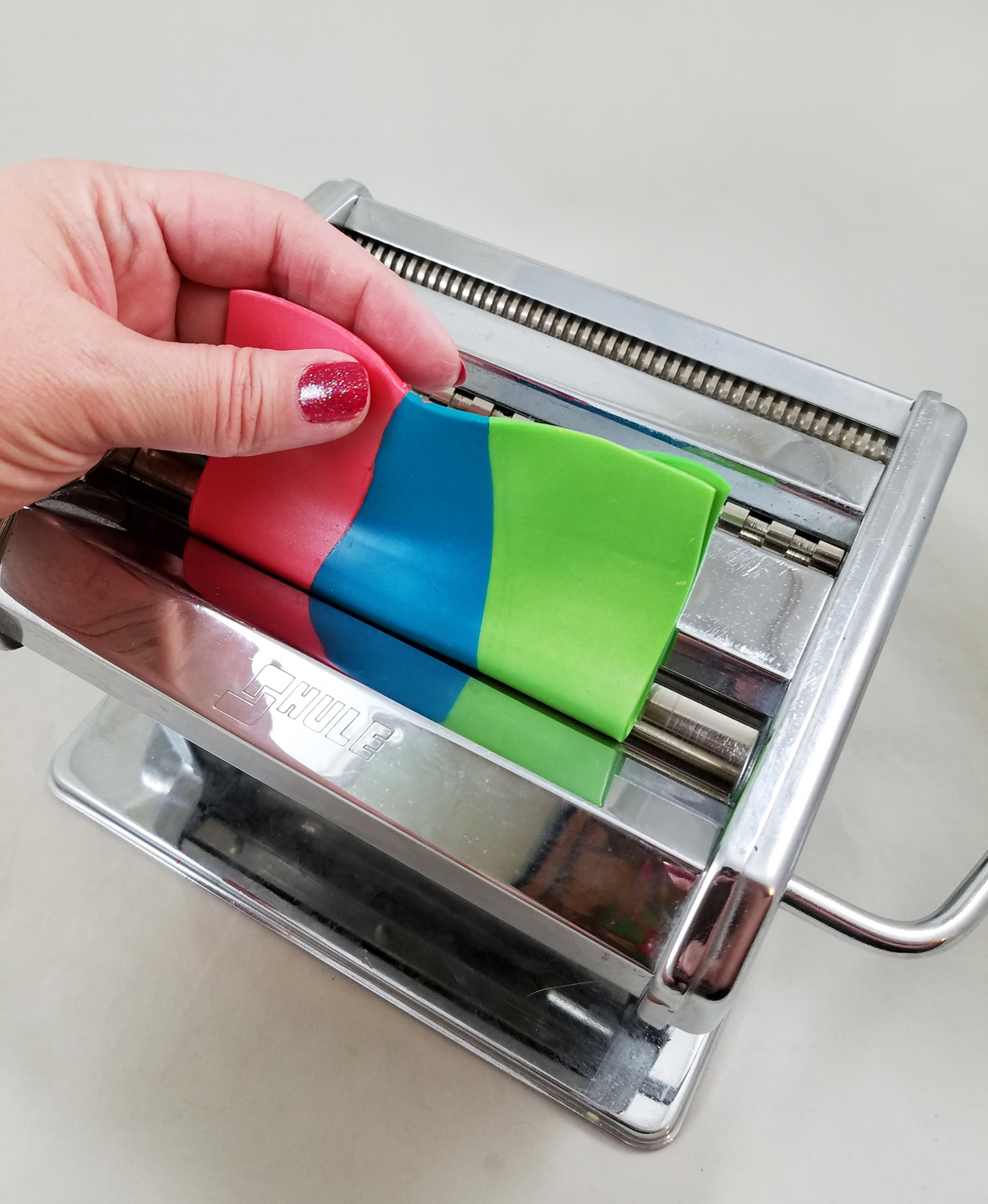
I then folded in half, top to bottom, the clay sheet making sure to match the colors on the sheet edges and once again run it through the pasta machine. I did that 10 more times, folding and rolling the clay sheet in the same direction.
*If you are new to trying this technique try it first with scrap clay to practice. Polyform Products has great video on how to create a Skinner Blend HERE.
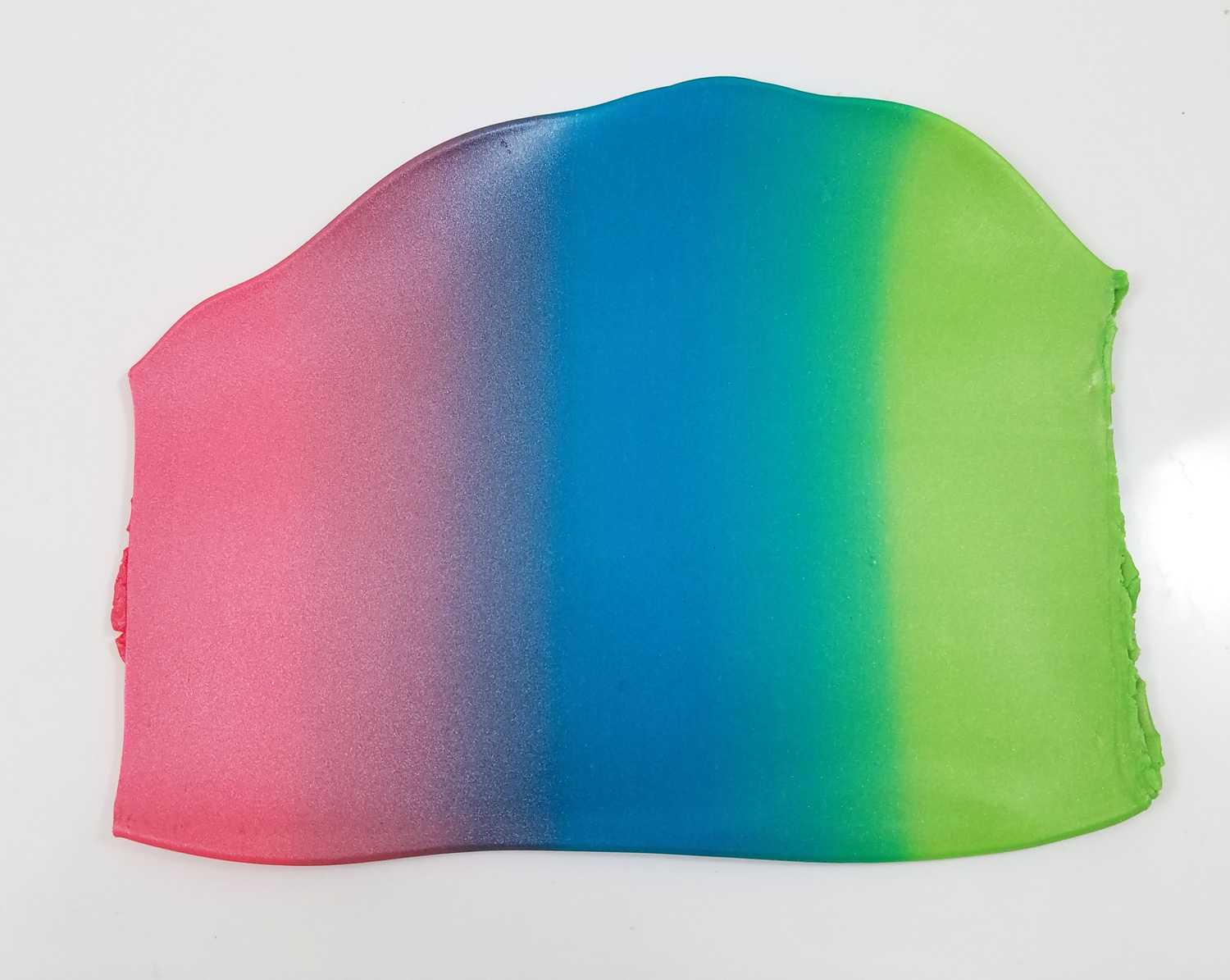
This gradient of colors is 10 fold-and-roll passes through the pasta machine, I wanted an even smoother transition of colors and ran the clay sheet a few more times through the pasta machine.
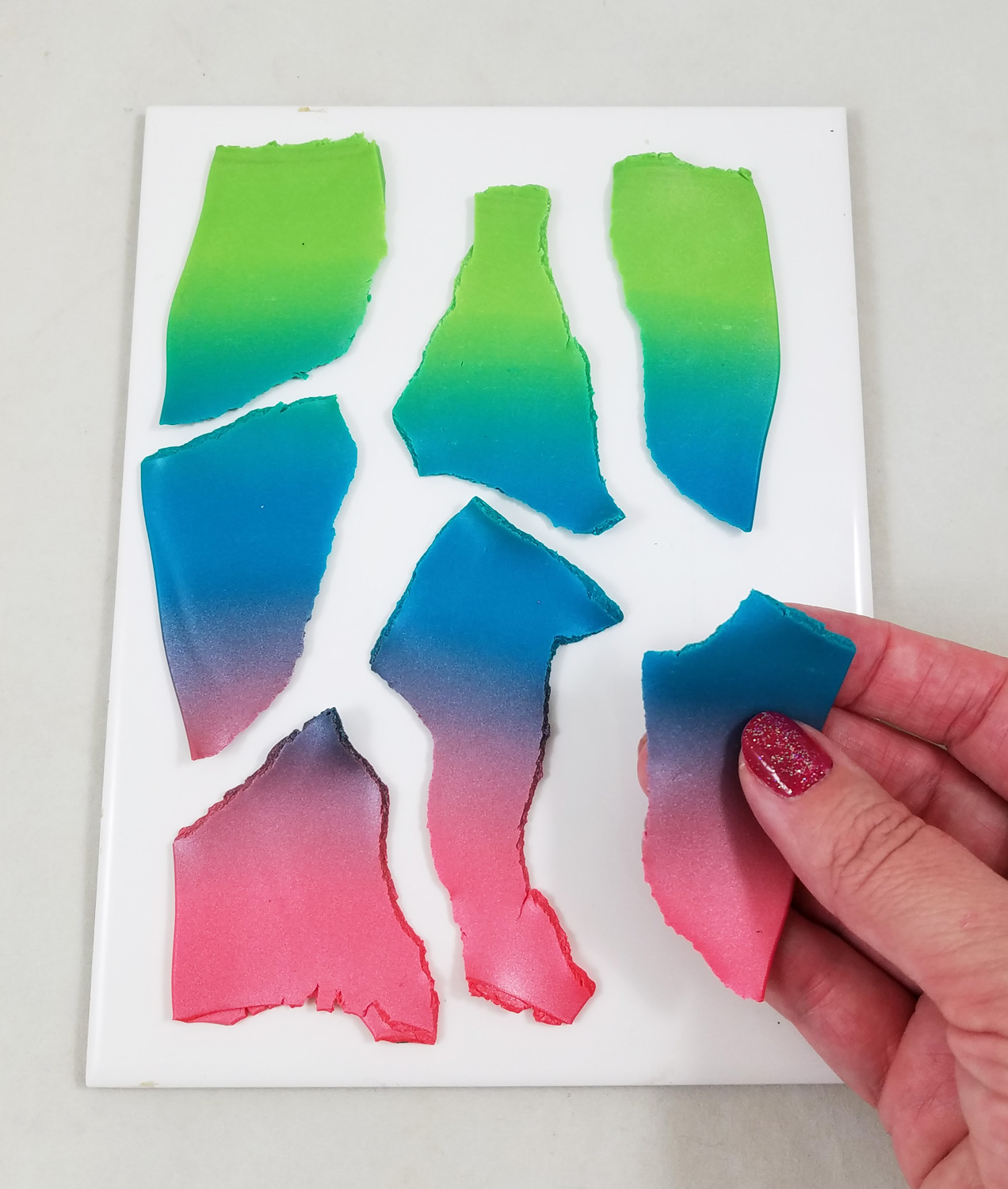
Once I got my clay sheet to the desired blend I carefully tore the gradient piece of clay into smaller pieces. This might seem a bit odd to do after all of the hard work getting a smooth gradient but stay with me!
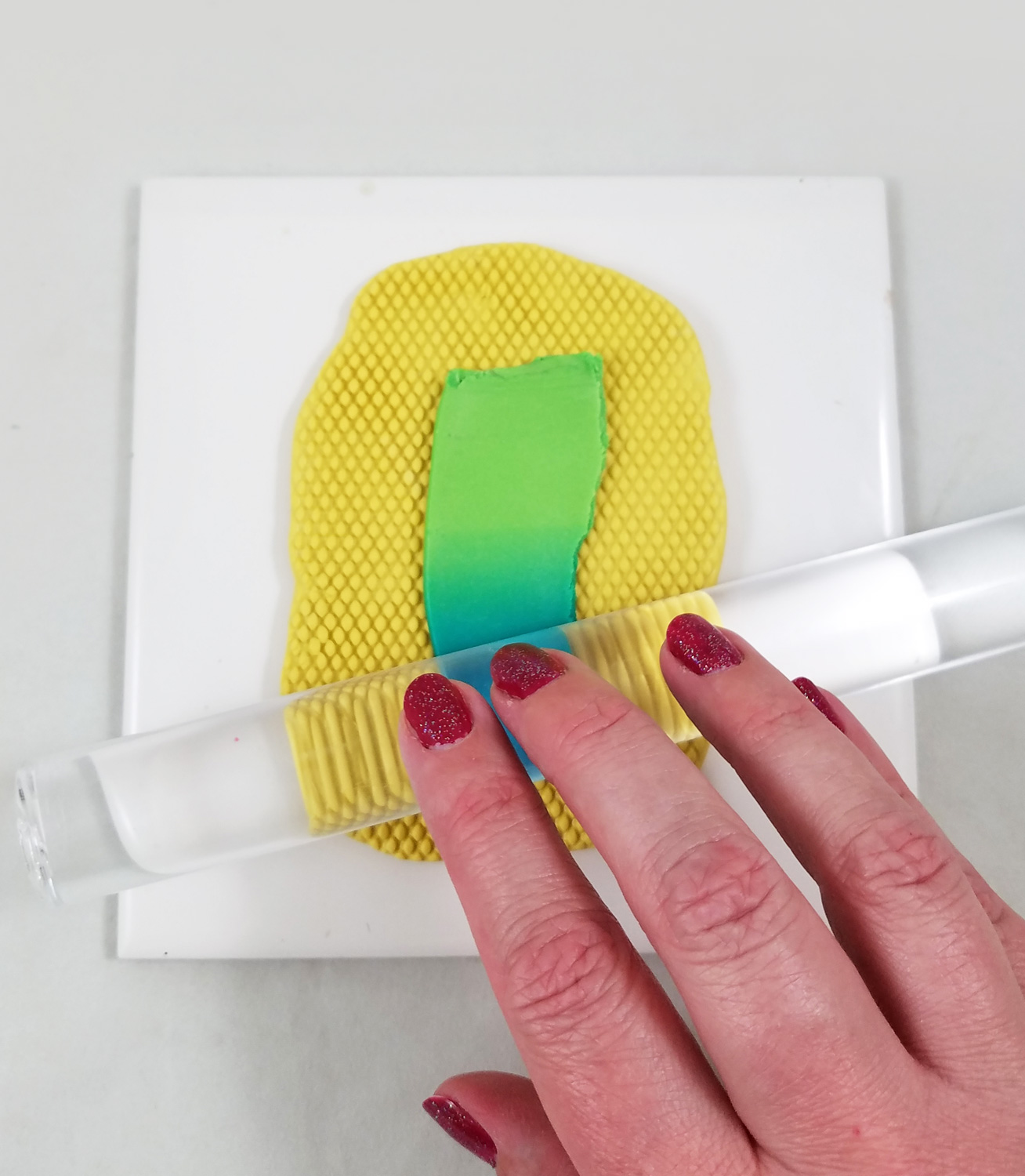
Taking each small torn piece of clay I placed it on my Amazing Mold Putty mesh texture plate and rolled an acrylic roller in a firm but consistent motion, careful to get as much texture as possible impressed into the soft clay.

Each textured piece of clay was placed on top of each other in a semi-circle shape, and pressed lightly at the edges to help stick each piece together.

Using a small stylus I fixed any portions of the clay that didn’t get a complete impression of the texture plate and pressed the edges more firmly together in the scale-like indents.
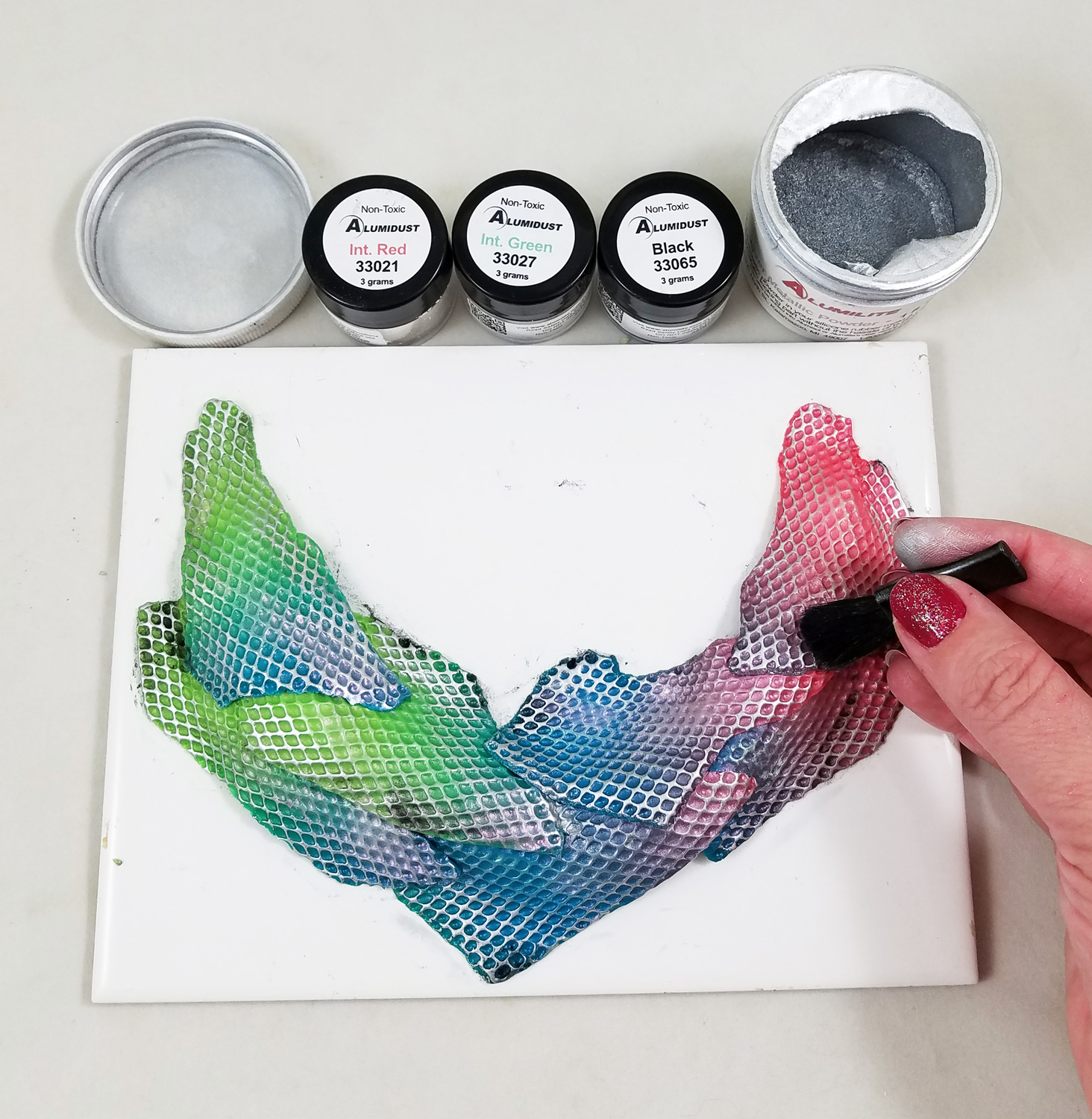
I twisted up half a paper towel into a tube shape, curved it into a semi-circle and placed in on the my ceramic tile. I then carefully removed my curved clay piece off the tile and laid it on top of the twisted paper towel, pushing the clay sides down every so slightly creating a raised portion. The raised form would give the clay more dimension and allow for a more dynamic application of metallic powders.
I dipped my finger in some Silver Alumilite Metallic Powder and gently ran my finger across the raised textured surface of the clay, highlighting the scaled texture. Using a soft makeup brush I applied Interference Red and Green Alumidust into the lower portions of the scale texture on the clay. I applied only a very small amount of the Black Alumidust to the edges of the clay. The powders bonded to the uncured polymer clay without the addition of a glue or sealant.
I made two holes on the top left and right of the necklace with a stylus; these would become holes to place jumprings and chain through once the clay is cured.
I then put the tile with the clay necklace into a toaster oven, heated per manufacturer instructions, to cure.
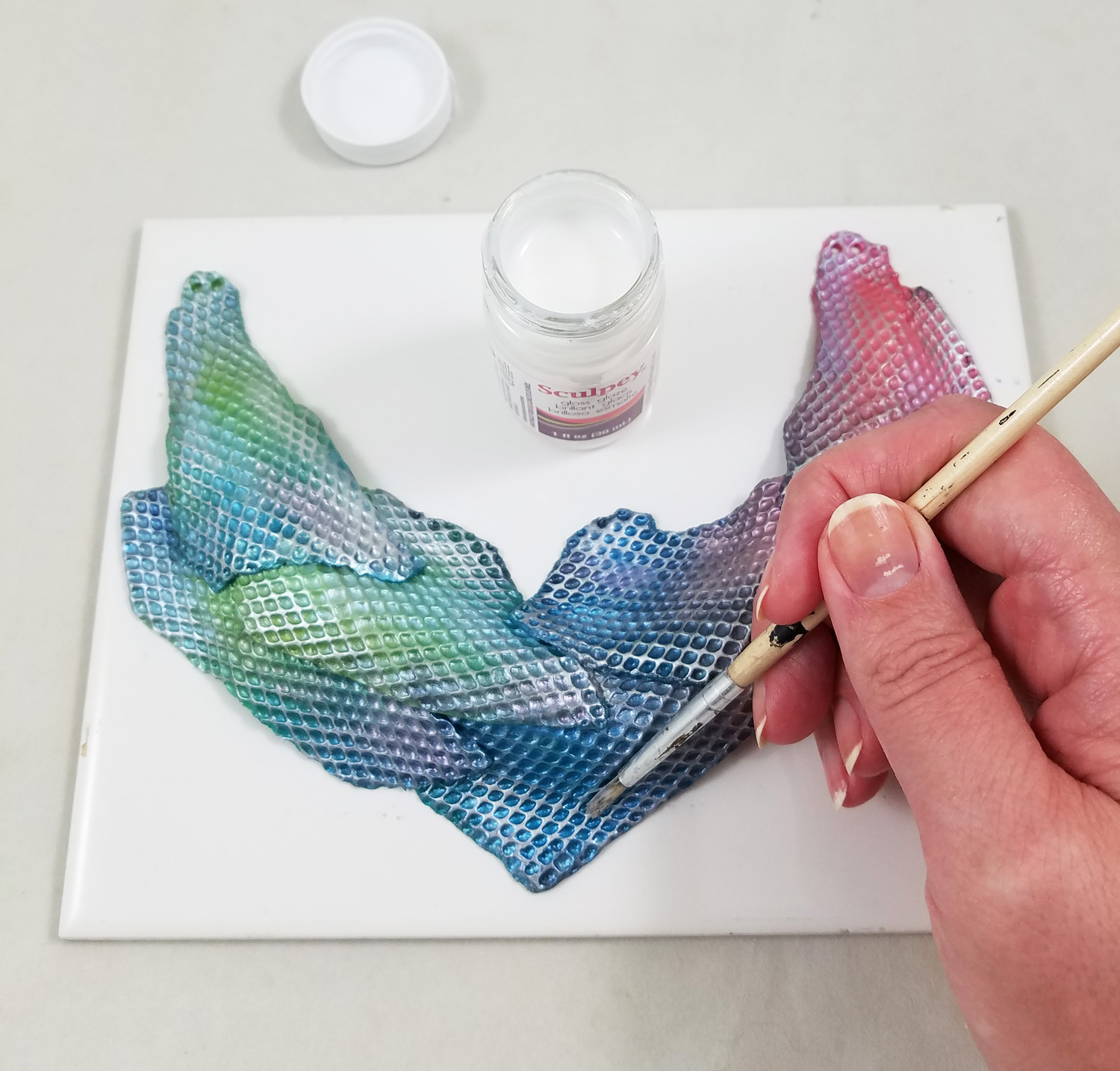
I painted on a coat of gloss Sculpey Glaze over the now cured piece of clay and let it dry per manufacturer instructions.
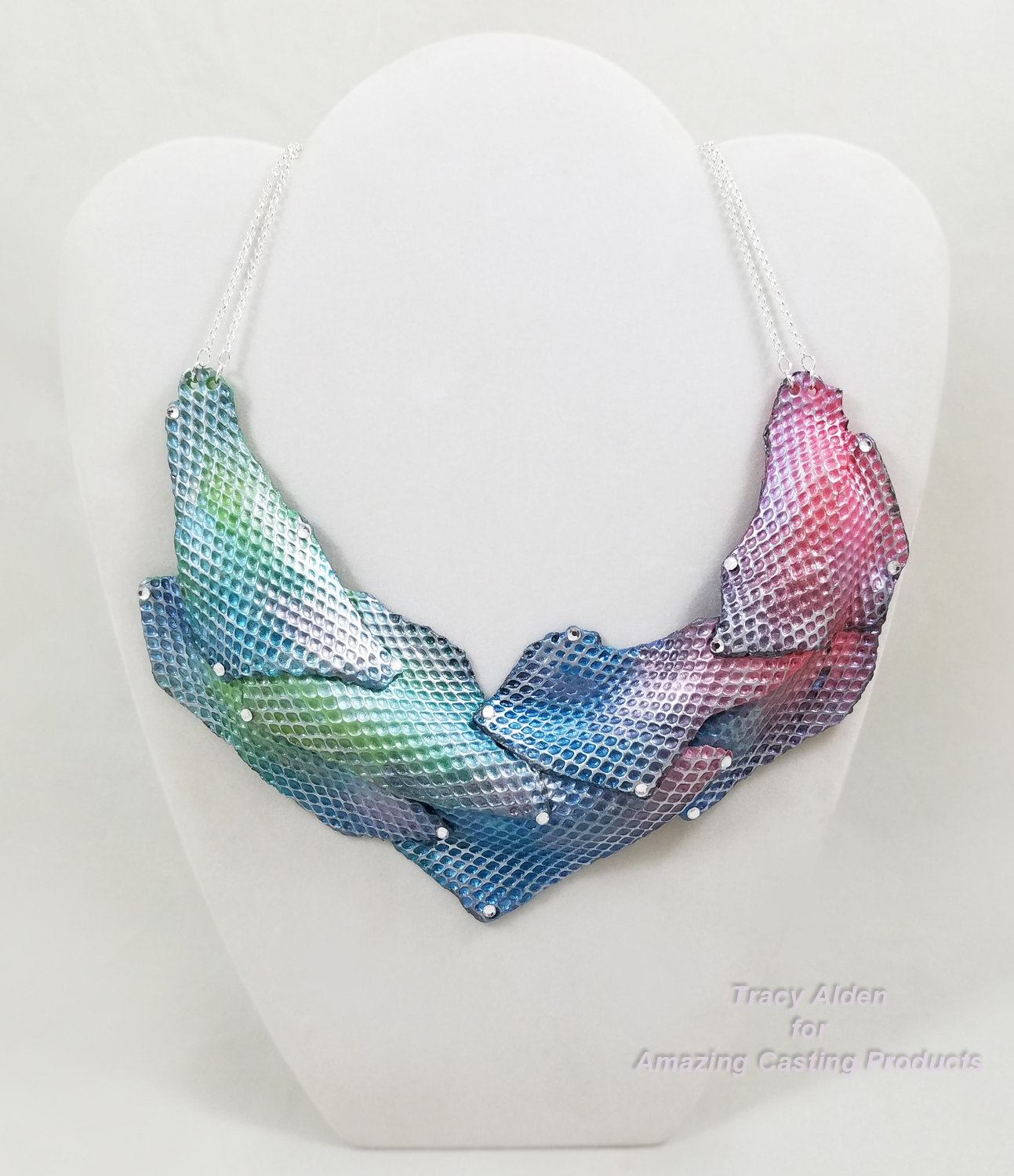
I applied little dots of Beacon’s Gem-Tac glue on the edges of the scales and I added flatback crystal rhinestones. I put jumprings through the two holes on each side and attached jewelry chain. Now the necklace was ready to wear!
Happy Holidays and until next time, safe travels!
This is an affiliate post, which means I received an assortment of products as a compensation for the creation of art. To read my full disclosure, click here.
Feather Inspired Boho Necklace with Sculpey Soufflé

In January I traveled to the Creativation Trade show, in Phoenix, Arizona. Held by Association For Creative Industries or AFCI, during the show I was invited to the 6th annual Prime Networking Event. At this event, bloggers, designers, authors and brands in the craft industry came together to network, make new partnerships, and learn about new product information. The event was Educational, informative, had great food and drinks and free product samples provided by this year’s sponsors. After the event attendees were encouraged to try out and create art for the Favecrafts Best Blogger Craft Event.
One of the sponsors was Polyform Products, who supplied a wonderful kit including a Sculpey® Bead Making Kit and three half bricks of Sculpey® Soufflé™ in Igloo, Pistachio and Poppy Seed.

The Souffle clay colors of the kit reminded me of the feathers of the Great Green Macaw. In particular the neck and chest feathers, in tones of green, black and fluffy white, that many Macaws can be seen preening while relaxing. This color inspiration helped me visualize a Boho necklace, faux leather in style, since Souffle Clay once baked in an oven has a matte finish, somewhat like leather.
Supplies:
Sculpey® Soufflé™ in Igloo, Pistachio and Poppy Seed
Sculpey® Bead Making Kit
Ceramic tiles
1 Coffee Straw
Pasta Machine
Paper Towels
Metal Spacer Beads
Cone Tin Beads
Toothbrush
Darice 100% Natural Hemp Cord, 20 lb. Assorted Brights
Cord Faux Suede Olive-Brown 3MM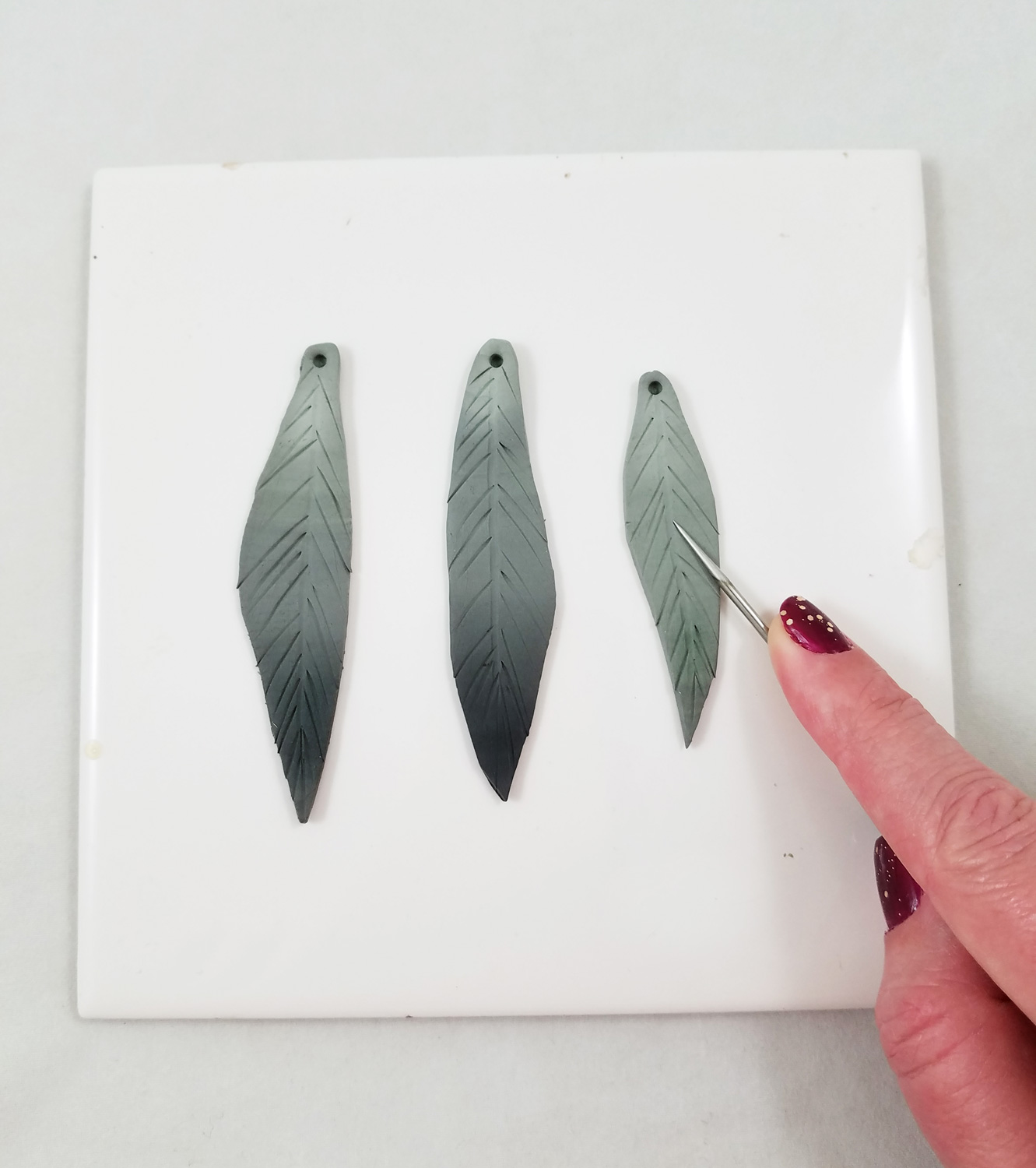
Working with the Sculpey Soufflé I quickly learned it is softer than most polymer clay, requiring little to no conditioning. Using the cutting blade, included in the bead making kit, I cut each brick in half, saving half of each clay brick for the second part of the project. I rolled out each half brick of clay with a pasta machine (devoted to craft use only) set on the thickest setting.
Using the Skinner Blend technique, which creates beautiful gradients in clay, I blended two of each color of clay. Now having pieces of clay with blends of green with black, white with black, green with white, I cut out 14 feather shapes using the cutting blade. I didn’t need to use a template because I wanted the organic look of naturally fallen feathers. Using a coffee straw I punched out a hole on the top of each feather. To give detail to the clay feathers I used the needle tool, included in the bead making kit, to draw on the clay, not going too deep but just enough to get create lines as shown in the photo above.

I placed a paper towel on a ceramic tile and carefully put my detailed feather pieces on top. I bent and curved the feather to give them a more natural flow. I baked the clay feathers on the tile as per the manufacturers instructions.
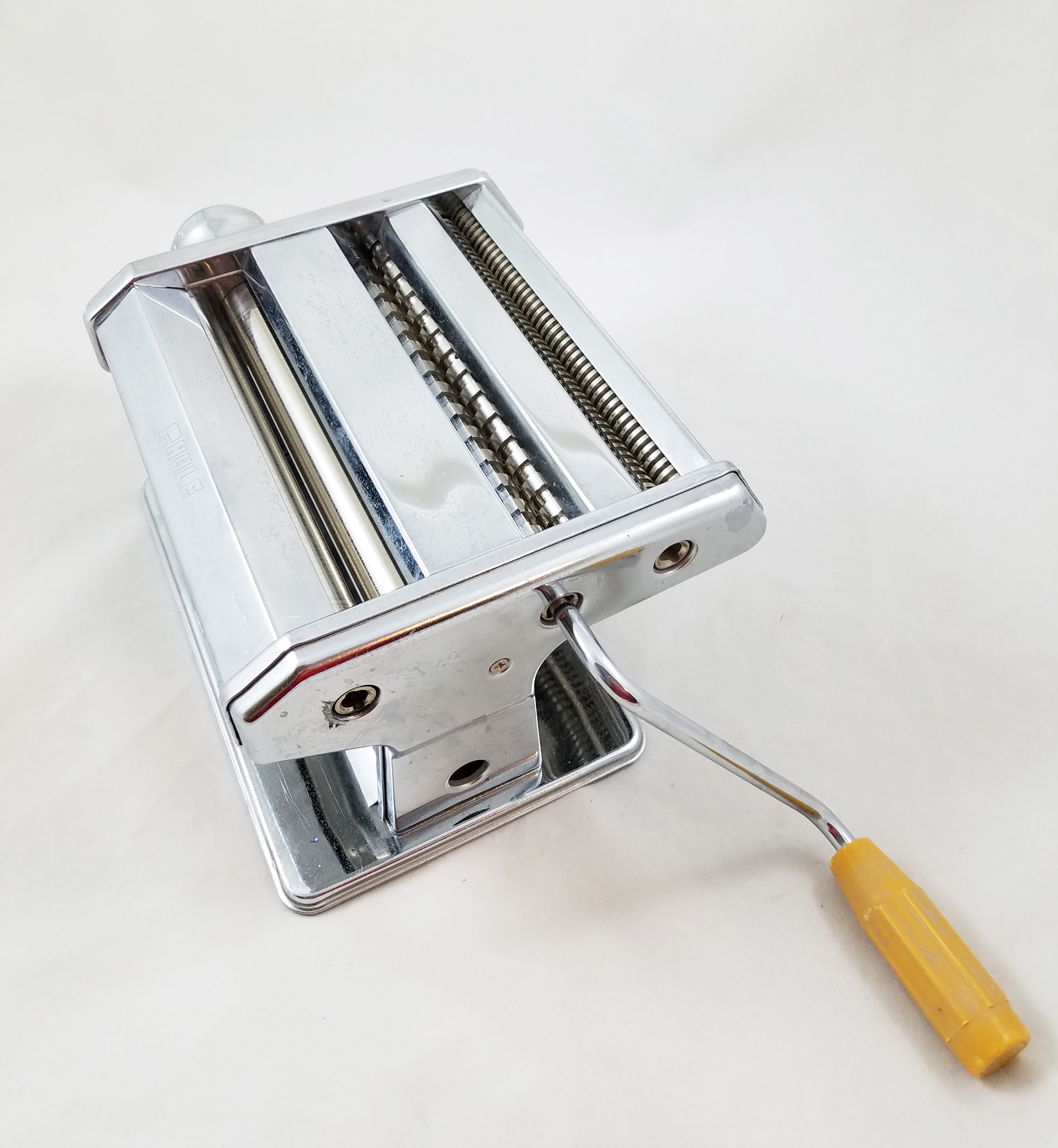
To condition and roll out polymer clay easier I use a Pasta Machine I got at a kitchen supply store. It also happens to have two noodle cutting rollers, that normally I ignore when using for clay. However the Fettuccine noodle roller was about to become very handy for the next part in my project.
*The use of a pasta machine with noodle cutting rollers is not necessary if you rather cut each strip out by hand.
I rolled out the reserved half bricks of clay with the pasta machine on the thickest setting. Then I ran each portion of clay through the Fettuccine cutting roller, making sure to run the white, then green and black clay last to avoid color transfer of clay. Each strip of clay was easily textured with a tooth brush to emulate the appearance of leather. Using a coffee straw I punched out a hole on the top of each strip of clay.
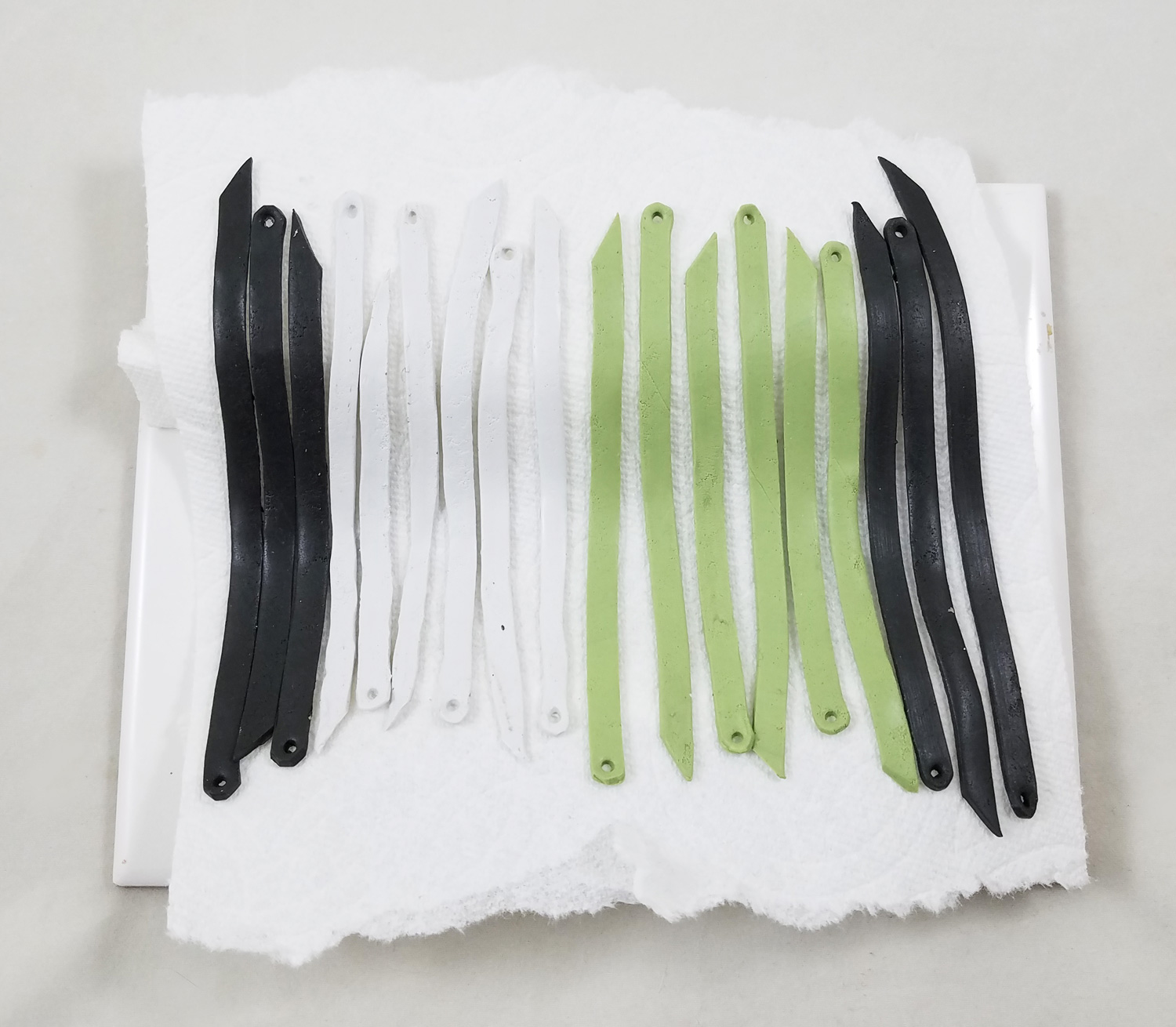
I crumpled two paper towels into rolls and placed a third paper towel on top of a ceramic tile. I carefully placed my strips of clay on the paper towels. I baked the clay strips on the tile as per the manufacturers instructions. Sculpey Soufflé once baked is more flexible than traditional polymer clay allowing for long and/or large art pieces to be created, yet be still resistant to cracking and breaking.
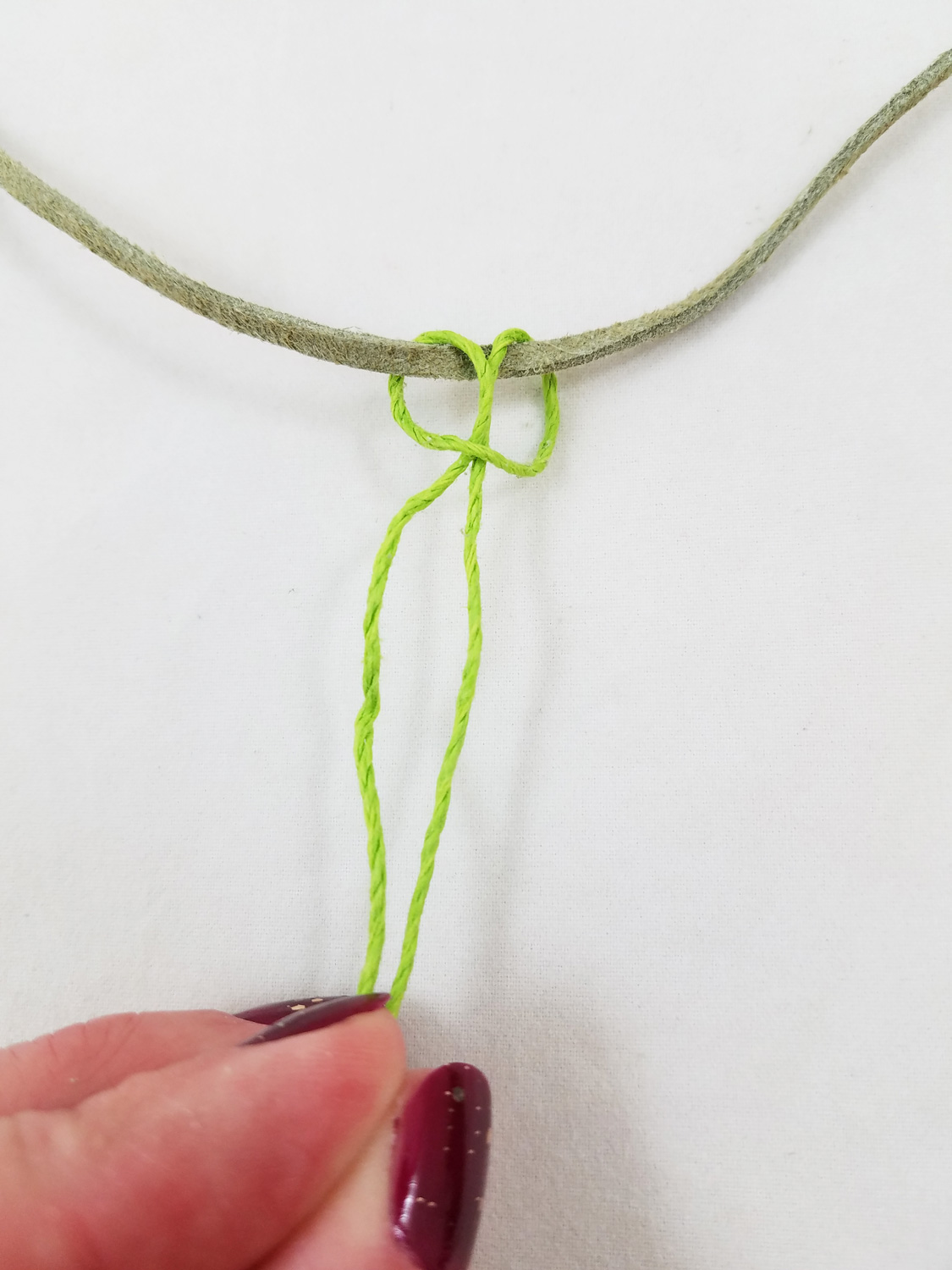
I cut a 24 inch portion of Faux Suede Olive-Brown Cord to be the start of my necklace. I cut a 10 inch portion of green Natural Hemp Cord and attached it to the suede cord using a Lark’s head (Cow Hitch) knot.
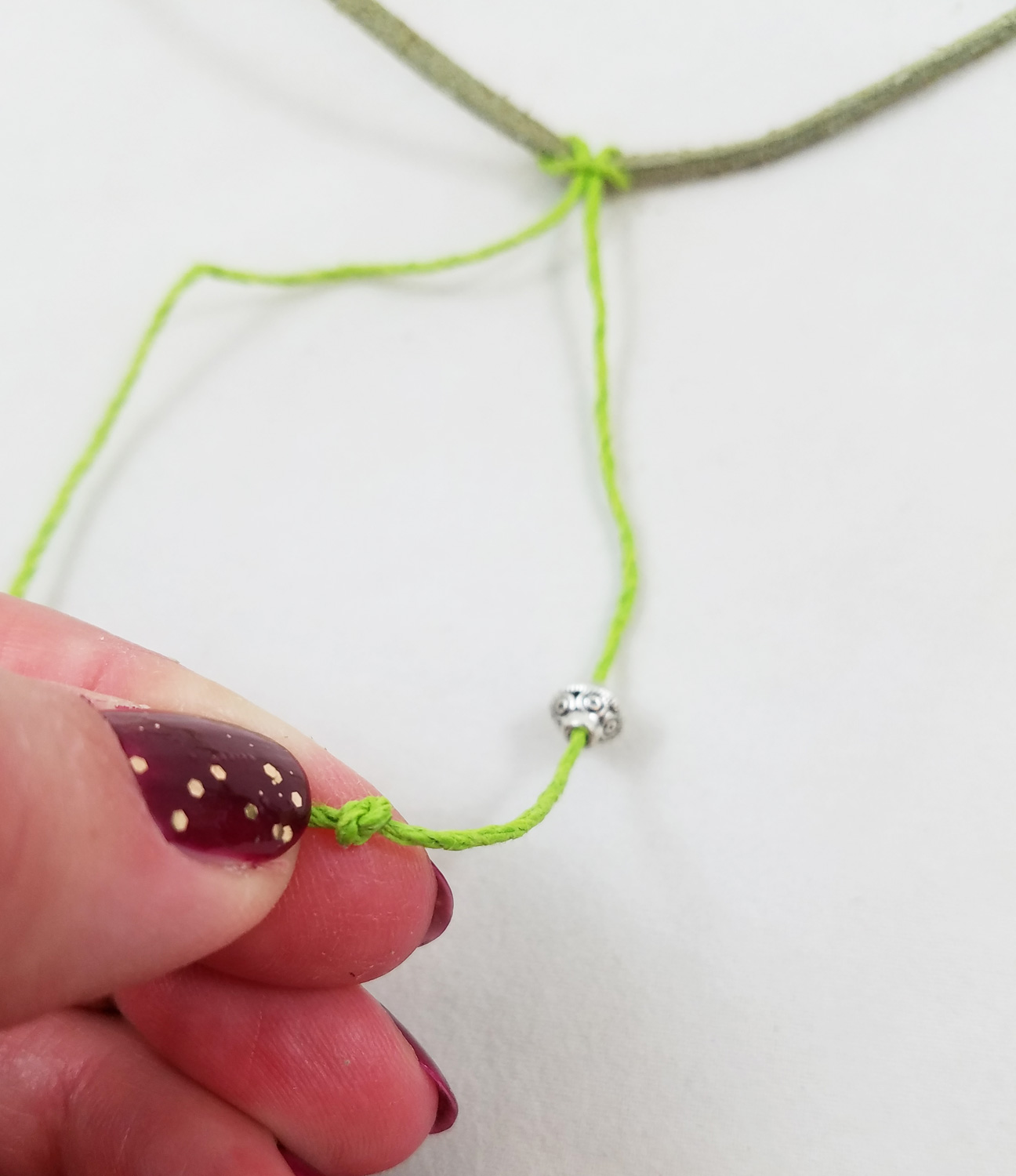
I slid a metal bead onto the hemp cord and did a overhand knot at the end of the cord. I repeated this on the second portion of the cord.
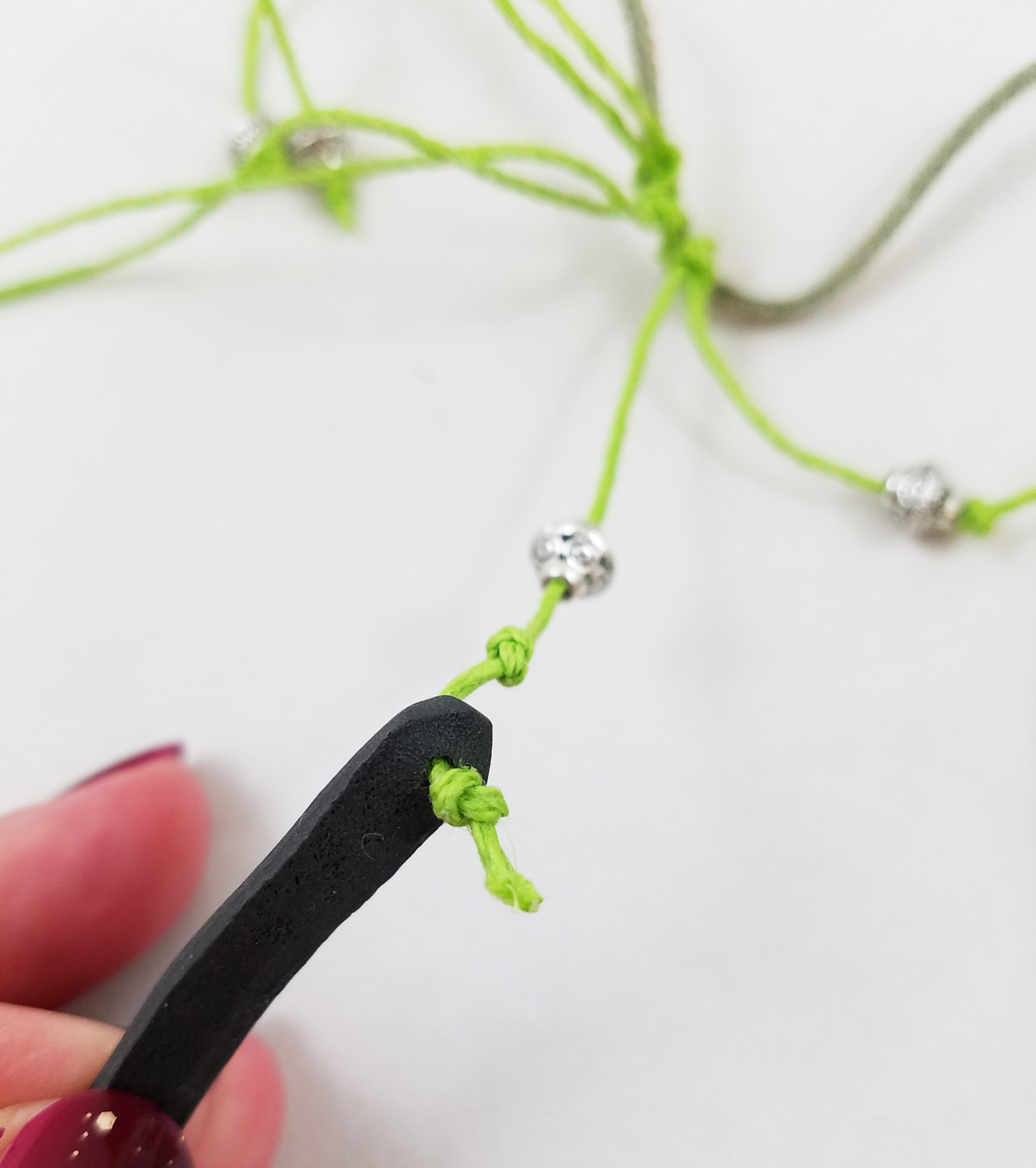
I added an additional 10 inch hemp cord length to the suede using a Lark’s Head knot, adding metal beads and securing them with overhand knots. Adding another hemp cord length I slid metal bead further down the cord, towards the Lark’s head knot. I did an overhand knot, slid on a strip of baked polymer Souffle clay and secured it with a overhand knot. I repeated this process for all of the other cured clay pieces.
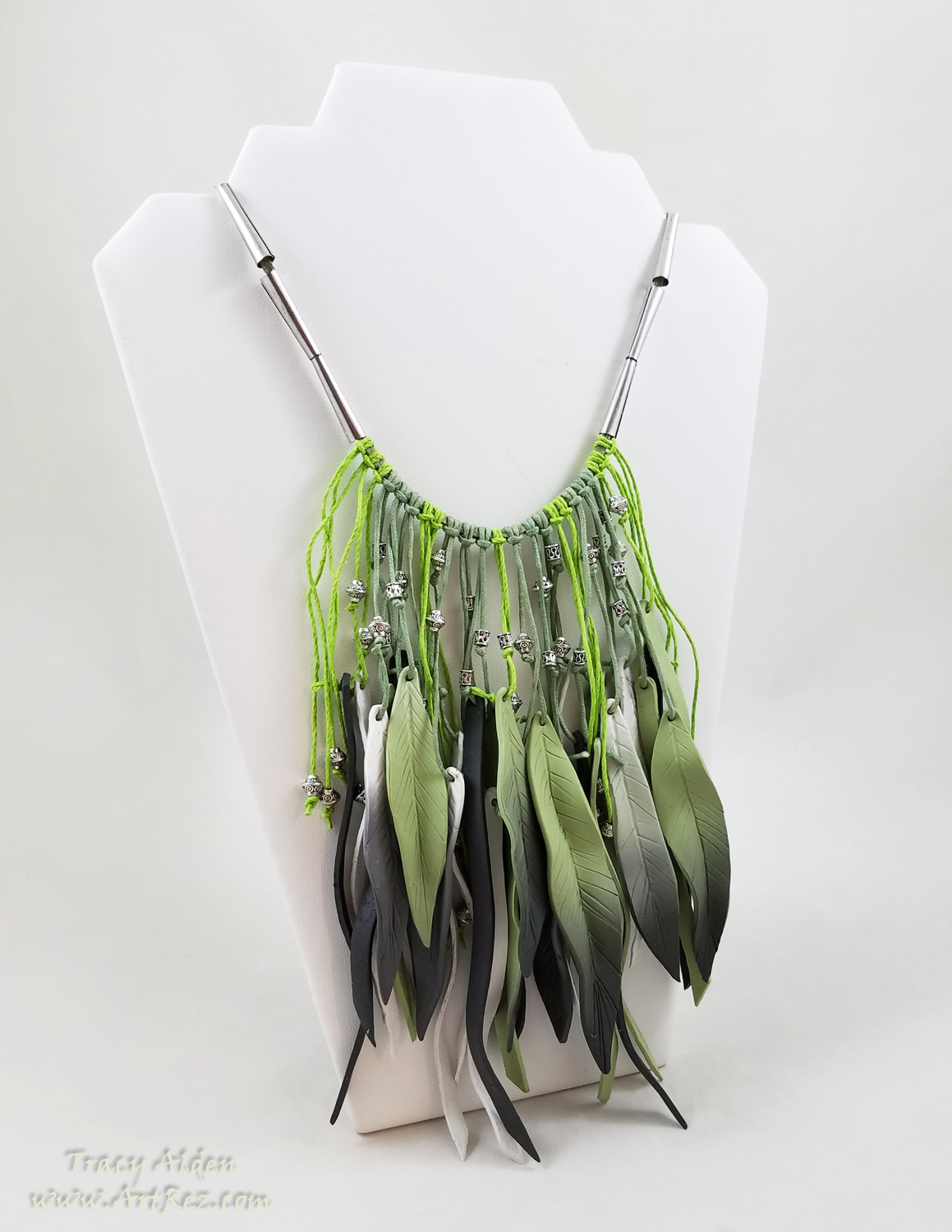
I slid on three Cone Tin Beads on each side of the suede and did a simple slide knot to finish the necklace.
I am now a huge fan of Sculpey Soufflé, with its flexibility and matte finish it allows this cascade of cord, clay and metal beads to be lightweight, durable and fashionable!Until Next Time, Safe Travels!
Polymer Clay Snowflakes Ornaments
With the weather changing and the nights getting pretty cold in our area I have been finding myself wanting to put out Winter decos in the house early. One of my favorite styles of Winter decorations is ornaments, but they don’t need a tree in our house! I hang them on garlands, from curtains and fireplace mantels. A fun and simple project I love to make with children in our family is polymer clay snowflakes! It just require a few basic polymer clay crafting tools and some imagination.
Supplies:
Premo! Sculpey Clay
Pluffy Clay
Pasta Machine/Clay Conditioning Machine
Snowflake Cookie Cutter *Once used with polymer clay do not use for food, just use it for crafts
Stylus
Rhinestones, beads or mini mirrors
Clear Plastic Wrap
Glitter
Jewelry Wire
Round needle nose pliers
Ceramic tile I mixed the Premo! and Pluffy clay together, a one to one ratio. Now you might be wondering why I using that mix of clay. Since we are making ornaments I wanted the pieces to be as light as possible, this is why I am using the Pluffy. I did a review of Polyform’s Pluffy a while back.
I mixed the Premo! and Pluffy clay together, a one to one ratio. Now you might be wondering why I using that mix of clay. Since we are making ornaments I wanted the pieces to be as light as possible, this is why I am using the Pluffy. I did a review of Polyform’s Pluffy a while back.
I conditioned and mixed the clays by running them through a pasta machine until they were thoroughly mixed on the the highest setting. I then placed the clay on a ceramic tile and with a piece of plastic wrap on top of the clay. Carefully I placed the snowflake shaped cookie cutter ontop of the clay covered in plastic wrap and firmly pressed down through the clay until it was cut. The plastic wrap creates a nice beveled edge that you would not get if you just pressed the cookie cutter through the clay.
I then placed the clay on a ceramic tile and with a piece of plastic wrap on top of the clay. Carefully I placed the snowflake shaped cookie cutter ontop of the clay covered in plastic wrap and firmly pressed down through the clay until it was cut. The plastic wrap creates a nice beveled edge that you would not get if you just pressed the cookie cutter through the clay.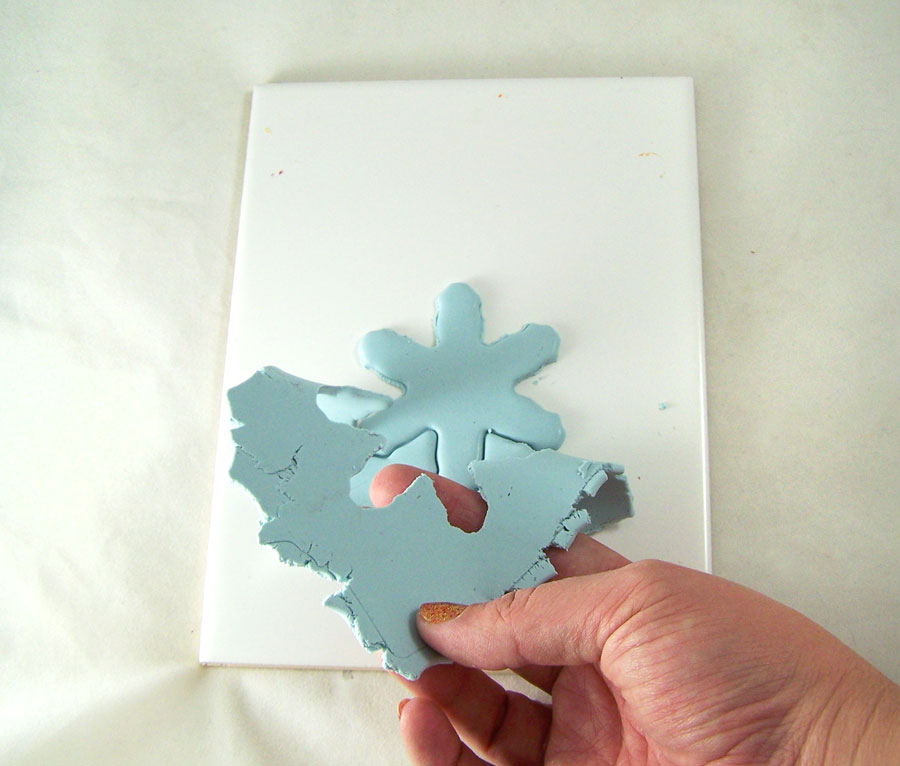 Carefully I removed the excess clay, leaving the snowflake cut out in place. Saving excess clay for another snowflake or project.
Carefully I removed the excess clay, leaving the snowflake cut out in place. Saving excess clay for another snowflake or project.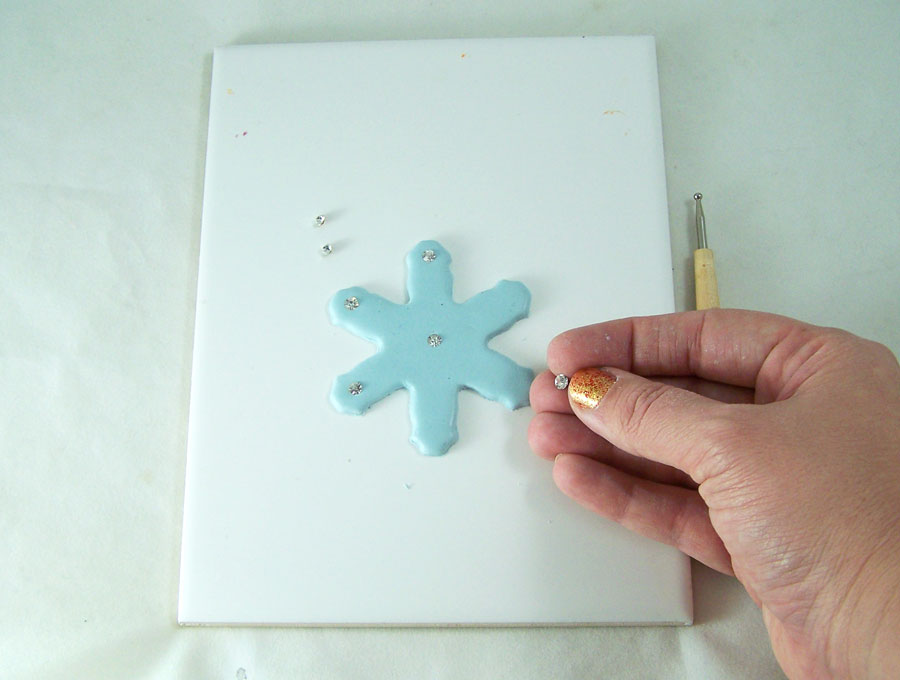 In this photo I put rhinestones in a pattern on the clay and press firmly into the clay but you can use any combination of rhinestones, beads or mirror pieces. There is no right or wrong way! 🙂
In this photo I put rhinestones in a pattern on the clay and press firmly into the clay but you can use any combination of rhinestones, beads or mirror pieces. There is no right or wrong way! 🙂 Using several stylus I indented little dot patterns into the clay. Any texture stamps or indentations will work, have fun and come up with all kinds of patterns!
Using several stylus I indented little dot patterns into the clay. Any texture stamps or indentations will work, have fun and come up with all kinds of patterns! I added some glitter to the clay by lighting sprinkling small pinches of glitter onto the clay and rubbing the glitter into the clay lightly.
I added some glitter to the clay by lighting sprinkling small pinches of glitter onto the clay and rubbing the glitter into the clay lightly.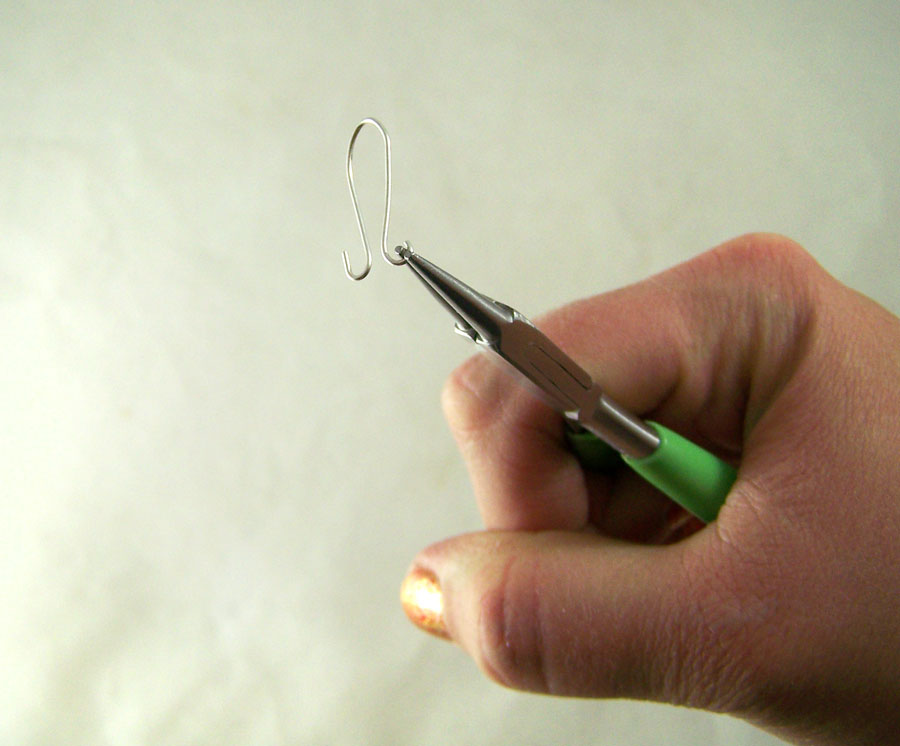 Using the round nose pliers I curled the edges of the jewelry wire; the curled edges will add an extra grip when pushed into the polymer clay.
Using the round nose pliers I curled the edges of the jewelry wire; the curled edges will add an extra grip when pushed into the polymer clay. Carefully I pushed the wire loop into the stop of the polymer clay snowflake and smoothed the clay around it.
Carefully I pushed the wire loop into the stop of the polymer clay snowflake and smoothed the clay around it.
I then placed the tile on a polyclay designated cookie pan and bake according to manufacture instructions. Once cool I degreased the snowflake with dish soap and water. I sealed the piece with a sealer and it now it is ready to hang up! Notice the ice clear snowflakes next to the polymer clay snowflakes? Well taking this project a step further you can make resin copies of the polymer clay snowflakes, mimicking the look of frozen ice!
Notice the ice clear snowflakes next to the polymer clay snowflakes? Well taking this project a step further you can make resin copies of the polymer clay snowflakes, mimicking the look of frozen ice!
Hop on over to the Amazing Crafting Products Blog for my clear resin snowflake tutorial!Mushrooms and Merriment…

As a young child one of my favorite Christmas decorations was glass mushroom ornaments. They were typically red with white dots and wonderful highlights of pearls, silver, gold and glitter. To me it was like a little frozen bit of fairyland. Traditionally the mushroom ornament was seen as a good luck symbol. In Germany they were seen as a symbol of a person’s love of nature and hope for good tidings in the New Year. Well that got me thinking I just had to make one of my own!Supplies:
Globecraft & Piccolo DIY Portrait Ornament
Globecraft & Piccolo 3D Enamel Gel Satin Honeydew
Globecraft & Piccolo 3D Enamel Gel Napthol Red
Globecraft & Piccolo Piccolo Enamel/Embossing Powder Adhesive
Globecraft & Piccolo Mossy Glen Enamel Powder
Globecraft & Piccolo Pure Sparkle Gold Glitter
Globecraft & Piccolo Glastique Gloss Finishing Glaze
Globecraft & Piccolo Medium FlourishesReindeer Moss
Polymer Clay Mushrooms
Ribbon
Red Sticker Gems
I started with applying the Piccolo Enamel Adhesive to the outer rings of the ornament. I then coated the rings with Mossy Glen Enamel Powder and heat set with heat gun. I then drew a thin bead of Glastique Gloss Finishing Glaze around the inside of the ovals, placed the globes in each half and clipped into place.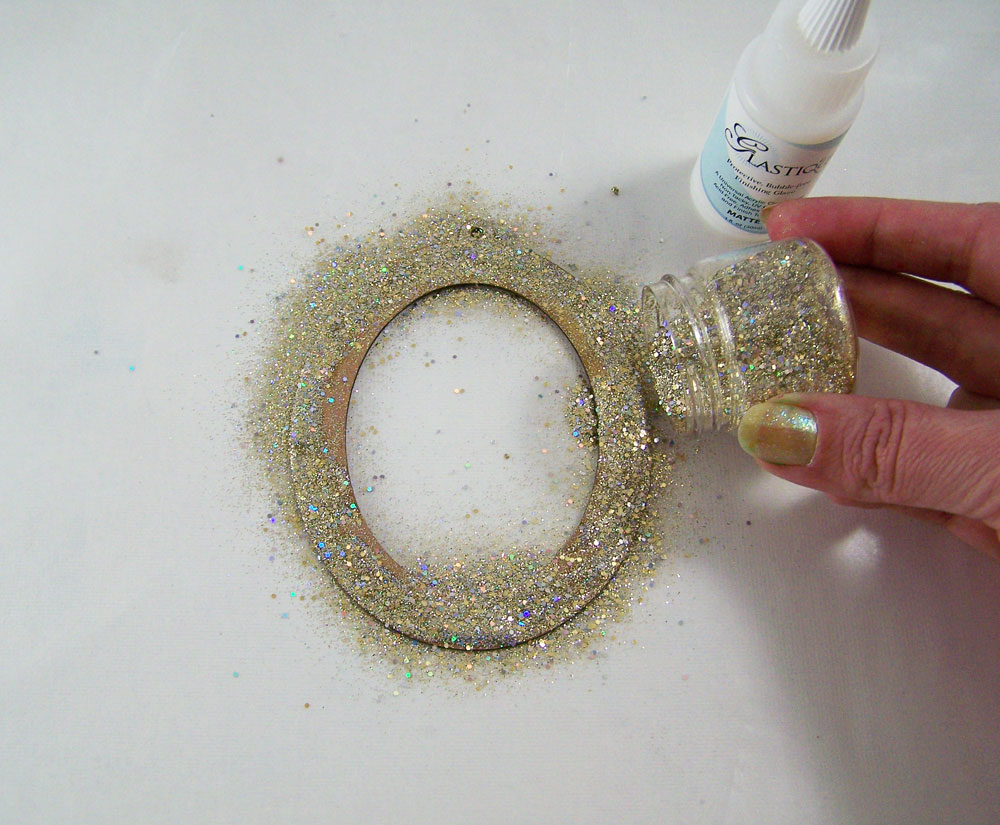
Taking the inner ring, I applied Glastique Gloss around the edge and sprinkled on Pure Sparkle Gold Glitter.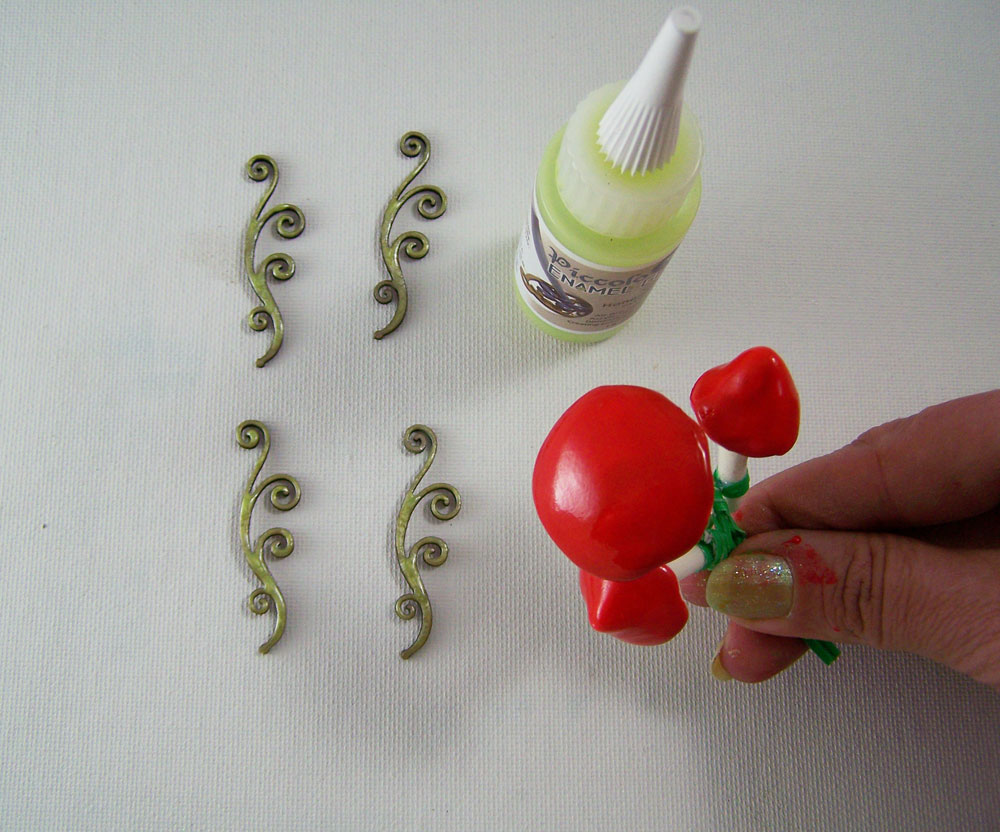
The flourishes got a coat of 3D Enamel Gel Satin Honeydew and the polymer clay mushrooms caps had a layer of 3D Enamel Gel Napthol Red applied. Let dry. Then little dots of Glastique Gloss on the mushroom caps and a sprinkle of Pure Sparkle Gold Glitter on top.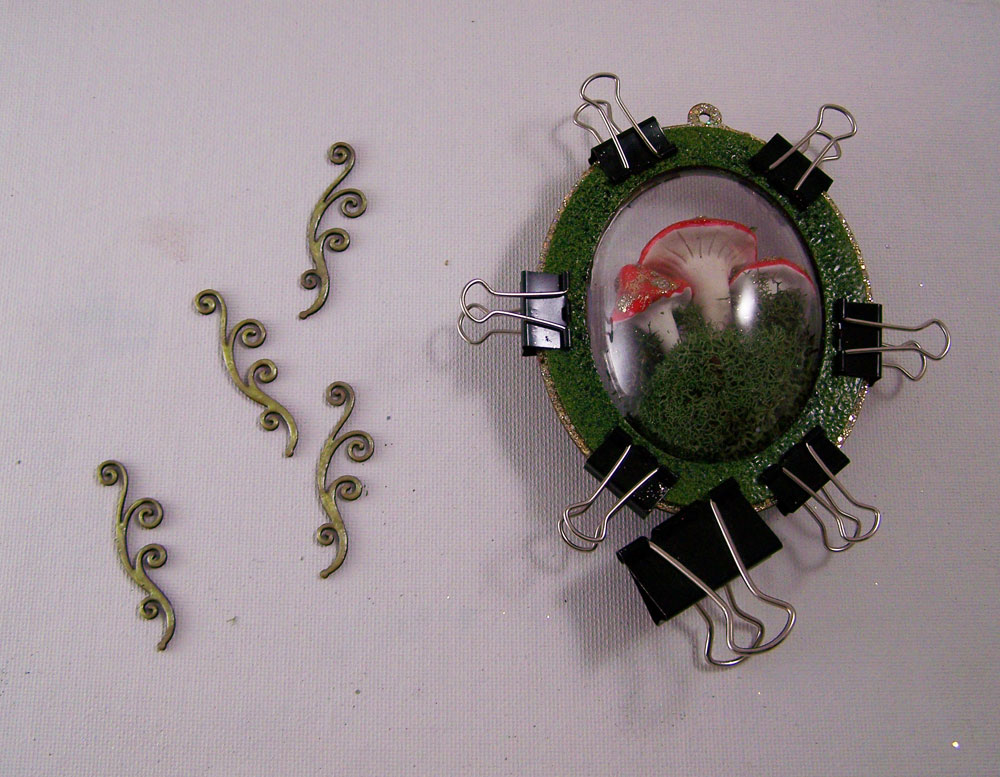
Once the mushroom are completely dry I bundled them together and wrapped Reindeer Moss around them tightly. I glued all the pieces of the ornament together with Glastique, carefully sandwiching the mushrooms and moss. I left them clipped in place until dry.
Using Glastique as glue once again, I added the flourishes and sticker gems to the ornament. Once dry I added the ribbon to the top!Hop on over to the Globecraft & Piccolo blog today to see my Christmas Airship Express tutorial!
Family of Pumpkins
I have pumpkins on the brain lately (sounds like a condition doesn’t it? LOL). I am trying to grow a pumpkin patch, wanting to make pumpkin pie, finding vintage ads of pumpkins and creating pumpkins out of polymer clay. I have always had fond memories of carving pumpkins, making pumpkin cakes and cookies with my family. To me they are what Fall, Halloween and harvest festivals are about.
This year I am making all kinds of Fall crafts but I wanted to make something showcasing pumpkins and the happy feeling of family together for the seasons. I started with making a cute little family of pumpkins out of polymer clay. I really liked how they came out but felt I could use them on so many projects such as cards, magnets, jewelry and wall decor. So I decided to make a mold of them so I could do all the projects I thought of and more.
For the pumpkin family mold I used:
Polymer clay (any brand or color will do since I made a mold from the original polymer piece)
Amazing Mold Putty
Amazing Casting Resin
Martha Stewart Crafts 2oz Multi-Surface Satin Acrylic Craft Paint Carrot, Jonquil and Beetle Black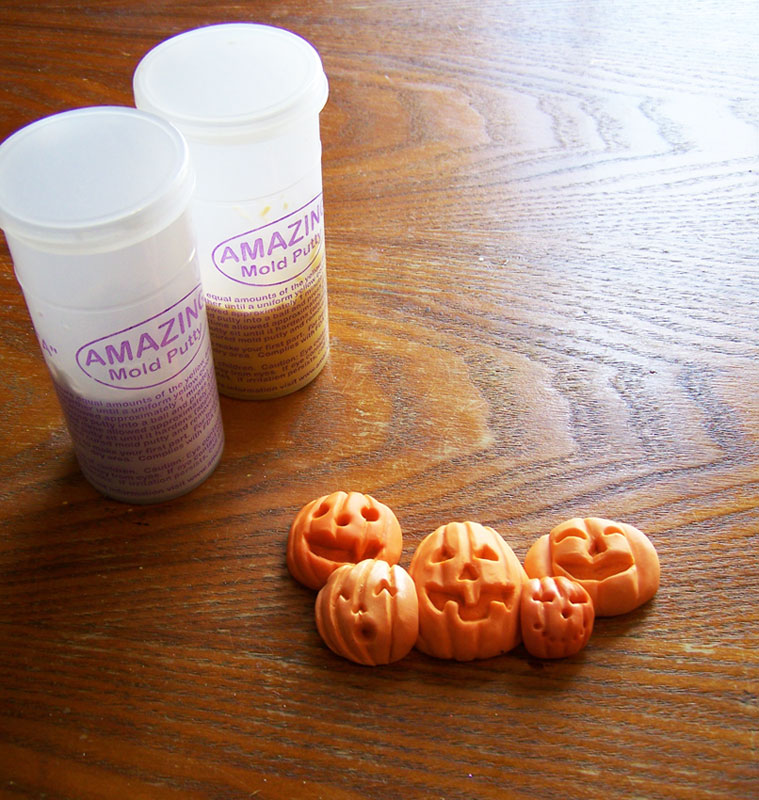
Here is the original pumpkin family made out of poly clay. I gave them deep smiles and happy faces, I don’t have to worry about any detail being lost since the Amazing Mold Putty does wonderful with anything with high detail.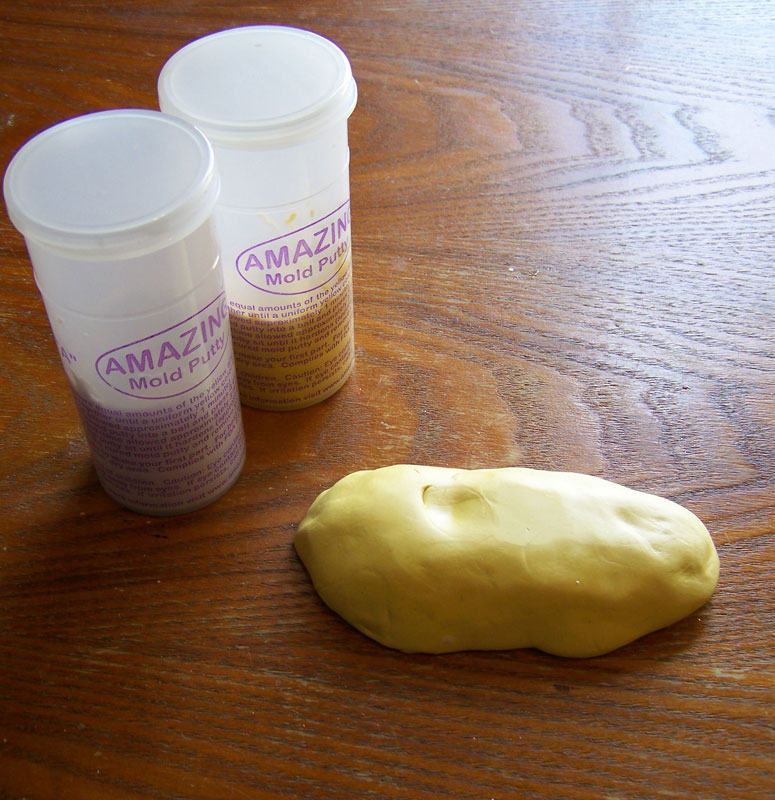
I mixed the putty according to the manufacture’s instructions, though the Amazing Mold Putty is rather forgiving if there is not exact amounts used. I do not attempt to remove the mold for at least 20 minutes to make sure the mold has set.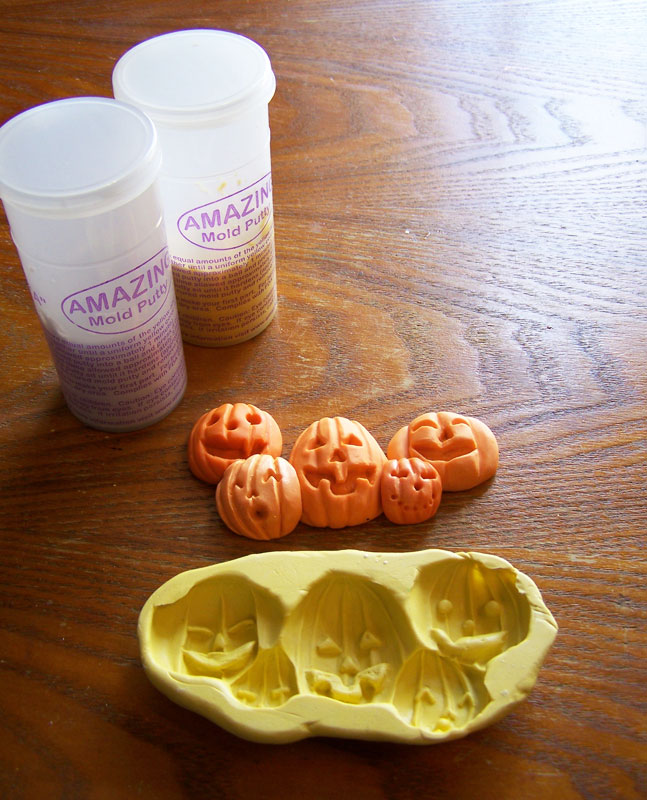 While the cure time for the molds is 20 minutes I like to leave the orignal in the molding putty for longer, making sure the mold is a rigid as possible (but keep in mind it is silicon and very flexible once cured) before trying to make any replicas. The mold can be cleaned with mild soap and water before you make any replicas to remove any loose particles left by the original.
While the cure time for the molds is 20 minutes I like to leave the orignal in the molding putty for longer, making sure the mold is a rigid as possible (but keep in mind it is silicon and very flexible once cured) before trying to make any replicas. The mold can be cleaned with mild soap and water before you make any replicas to remove any loose particles left by the original.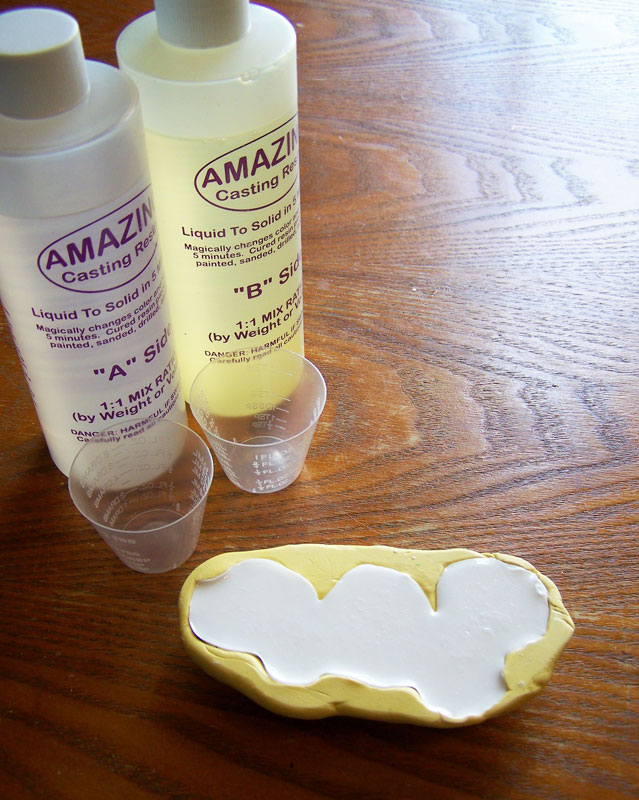 When mixing the Amazing Casting Resin I have to be careful about stirring too fast and for too long. Once the two parts are combined stir carefully until clear, scraping sides, about 15-20 seconds. I then immediately start to pour the resin into the mold; be careful not to pour too quick as you will increase the amount of air bubbles. It will set in 10 minutes, but keep in mind that the thicker the piece the faster the cure time. In this case the pumpkin family is a thick piece and set in about 8 minutes.
When mixing the Amazing Casting Resin I have to be careful about stirring too fast and for too long. Once the two parts are combined stir carefully until clear, scraping sides, about 15-20 seconds. I then immediately start to pour the resin into the mold; be careful not to pour too quick as you will increase the amount of air bubbles. It will set in 10 minutes, but keep in mind that the thicker the piece the faster the cure time. In this case the pumpkin family is a thick piece and set in about 8 minutes.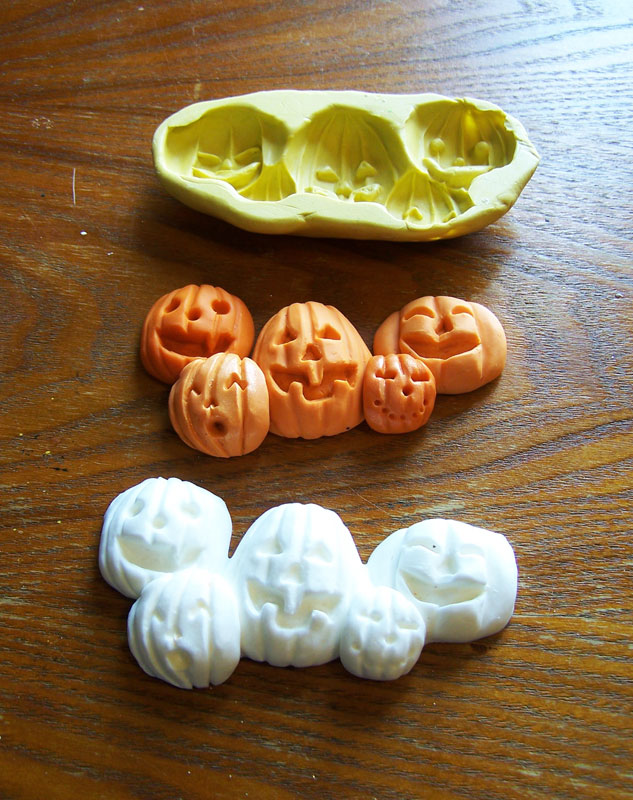 Here the resin copy is next to the original and the mold. Once the piece is cured I demold, trim any rough edges, sand and started painting.
Here the resin copy is next to the original and the mold. Once the piece is cured I demold, trim any rough edges, sand and started painting.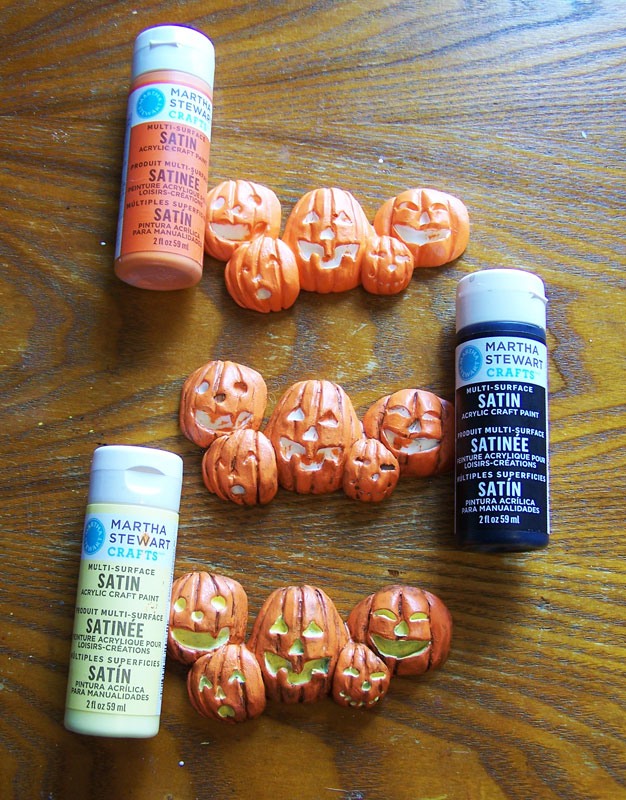
Here I show the 3 stages of painting. I have found that the Martha Stewart Crafts Multi-Surface acrylic paint bonds well with the resin replicas. I start with the Carrot, then a color wash of Beetle Black and then paint the Jonquil paint only in the eyes, noses and mouths of the pumpkin family.The first project I wanted to make with a pumpkin family was a home decor piece for my mother. She loves the holidays and always likes to have the family home to celebrate.
For the home decor piece I used:
Globecraft Memories Classic Fancy Rectangle
Globecraft Memories Glastique Gloss Finishing Glaze
Globecraft Memories Enamel powders 24K Gold and Mossy Glen
Globecraft Memories Piccolo Accents
Cardstock (any color or brand will work, I used orange, metallic white and black)
Mini Fall Leaves (most local craft stores carry small bags of fabric or paper leaves in the scrapbooking or floral sections)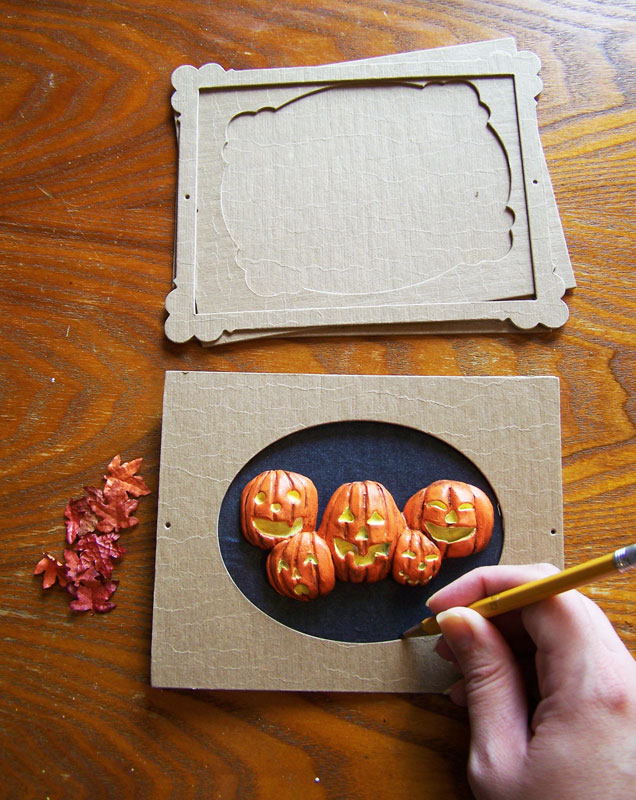 Using one of the finished pumpkin resin pieces, I placed it in the middle of the Classic Fancy Rectangle and traced along the inside of the oval to make sure the background paper, pumpkins and a leaf embellishments fit inside the globe.
Using one of the finished pumpkin resin pieces, I placed it in the middle of the Classic Fancy Rectangle and traced along the inside of the oval to make sure the background paper, pumpkins and a leaf embellishments fit inside the globe. Once I decorated the outer layers of the frame with the paper, enamel and Piccolos, I coated the outside layers with two coats Glastique Gloss glaze. Once completely dry I glued the layers and globe with Glastique together. I then glued the pumpkin resin piece to the backplate of the frame with a thick layer of Glastique. I carefully added the mini leaves around the bottom of the pumpkin family to give them a “bed” of leaves to be on.
Once I decorated the outer layers of the frame with the paper, enamel and Piccolos, I coated the outside layers with two coats Glastique Gloss glaze. Once completely dry I glued the layers and globe with Glastique together. I then glued the pumpkin resin piece to the backplate of the frame with a thick layer of Glastique. I carefully added the mini leaves around the bottom of the pumpkin family to give them a “bed” of leaves to be on.

Glue the top layers of the the frame to the backplate with Glastique and once dry it is now ready to hang on the wall! 🙂Until next time, Safe Travels!



